Assets

Accelerating Relational Database Workloads with 16G Dell PowerEdge R6625 Servers Equipped with PCIe 5.0 E3.S
Thu, 08 Feb 2024 02:28:42 -0000
|Read Time: 0 minutes
Summary
The latest 16G Dell PowerEdge R6625 servers support the PCIe 5.0 interface and the Enterprise and Datacenter Standard Form Factor (EDSFF) E3.S form factor. They deliver significant performance benefits and an improved system airflow that enhances heat dissipation. This can lead to less thermal throttling and increased lifespans for system components such as CPUs, memory and storage when compared with prior PCIe generations deployed with 2.5-inch1 form factor SSDs.
The purpose of this tech note is to present a generational server performance and power consumption comparison using PostgreSQL® relational database2 workloads. It compares 16G Dell PowerEdge R6625 PCIe 5.0 E3.S servers deployed with KIOXIA CM7-R Series E3.S enterprise NVMe SSDs with a previous generation system configuration.
The test results indicate that the latest 16G Dell PowerEdge R6625 servers deliver almost twice the relational database transactions using approximately the same amount of power when compared with the previous generation system.
Market positioning
Relational databases are vital to today’s data centers as they store an overwhelming amount of data captured on premises and at the edge of the network. Sales transactions and information relating to customers, vendors, products and financials represent key data.
IT teams need solutions that scale their data center storage platforms to better address large datasets and future growth. As these databases are dependent on fast underlying storage, one way to achieve high performance and scalability is by utilizing servers equipped with enterprise SSDs based on the latest PCIe 5.0 interface and the NVMe 2.0 protocol. The PCIe 5.0 revision can move data through the PCIe interface almost twice as fast when compared with the previous PCIe
4.0 generation. This enables SSDs to deliver input/output (I/O) even faster while requiring fewer servers to achieve the same level of performance.
With the recent availability of EDSFF SSDs, storage performance and total capacity per server can also increase. Servers with EDSFF E3.S slots deployed with E3.S SSDs deliver fast data throughput, fast input/output operations per second (IOPS) performance, low latency, high density and thermally optimized capabilities.
Product Features
Dell PowerEdge 6625 Rack Server (Figure 1)
Specifications: https://www.delltechnologies.com/asset/en-us/products/servers/technical-support/poweredge-r6625-spec- sheet.pdf.

Figure 1: Side angle of Dell PowerEdge 6625 Rack Server3
KIOXIA CM7 Series Enterprise NVMe SSD (Figure 2) Specifications:https://americas.kioxia.com/en-us/business/ssd/enterprise-ssd.html.
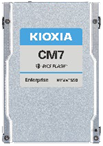
Figure 2: Front view of KIOXIA CM7 Series SSD4
PCIe 5.0 and NVMe 2.0 specification compliant; Two configurations: CM7-R Series (read intensive), 1 Drive Write Per Day5 (DWPD), up to 30,720 gigabyte6 (GB) capacities and CM7-V Series (higher endurance mixed use), 3 DWPD, up to 12,800 GB capacities.
Performance specifications: SeqRead = up to 14,000 MB/s; SeqWrite = up to 7,000 MB/s; RanRead = up to 2.7M IOPS; RanWrite = up to 600K IOPS.
Hardware/Software test configuration
The hardware and software equipment used in this virtualization comparison (Figure 3):
Server Information | ||
Server Model | Dell PowerEdge R6625 | Dell PowerEdge R6525 |
No. of Servers | 1 | 1 |
CPU Information | ||
CPU Model | AMD EPYC™ 9334 | AMD EPYC 7352 |
No. of Sockets | 2 | 2 |
No. of Cores | 32 | 24 |
Memory Information | ||
Memory Type | DDR5 | DDR4 |
Memory Speed (in megatransfers per second) | 4,800 MT/s | 3,200 MT/s |
Memory Size (in gigabytes) | 384 GB | 128 GB |
SSD Information | ||
SSD Model | KIOXIA CM7-R Series | KIOXIA CM6-R Series |
SSD Type | Read intensive | Read intensive |
Form Factor | E3.S | 2.5-inch (U.3) |
Interface | PCIe 5.0 x4 | PCIe 4.0 x4 |
Interface Speed (in gigatransfers per second) | 128 GT/s | 64 GT/s |
No. of SSDs | 4 | 4 |
SSD Capacity (in terabytes6) | 3.84 TB | 3.84 TB |
DWPD | 1 | 1 |
Active Power | up to 24 watts | up to 19 watts |
Operating System Information | ||
Operating System (OS) | Ubuntu® | Ubuntu |
OS Version | 22.04.2 | 22.04.2 |
Kernel | 5.15.0-76-generic | 5.15.0-76-generic |
RAID | RAID 57 | RAID 5 |
RAID Version | mdadm 4.2 | mdadm 4.2 |
Test Software Information | ||
Software | HammerDB8 | HammerDB |
Benchmark | TPROC-C9 | TPROC-C |
Version | 4.8 | 4.8 |
No. of Virtual Users | 128 | 128 |
Figure 3: Hardware/software configuration used in the comparison
For additional information regarding PostgreSQL relational database parameters and the OS tuning parameters used in this comparison, see Appendix A.
Set-up and test procedures
Set-up #1:
A Dell PowerEdge 6625 Rack Server was set-up with the Ubuntu 22.04.2 operating system.
Additional OS level parameters were adjusted to help increase system performance (to adjust these parameters, refer to Appendix A).
The system was rebooted.
Four 3.84 TB KIOXIA CM7 Series SSDs were placed in a RAID 5 set (via mdadm) to hold the PostgreSQL database in the server.
An XFS® file system was placed on top of the RAID 5 set and was mounted with noatime10 and discard11 flags. PostgreSQL relational database was installed in the server and the service was started.
HammerDB test software was installed on the server for the KIOXIA CM7 Series SSDs, enabling the TPROC-C online transaction processing (OLTP) workloads to run against the PostgreSQL database.
Set-up #2:
A Dell PowerEdge 6525 Rack Server was set-up with the Ubuntu 22.04.2 operating system.
Additional OS level parameters were adjusted to help increase system performance (to adjust these parameters, refer to Appendix A).
The system was rebooted.
Four 3.84 TB KIOXIA CM6 Series SSDs were placed in a RAID 5 set (via mdadm) to hold the PostgreSQL database in the server.
An XFS file system was placed on top of the RAID 5 set and was mounted with noatime and discard flags. PostgreSQL relational database was installed in the server and the service was started.
HammerDB test software was installed on the server for the KIOXIA CM6 Series SSDs, enabling the TPROC-C OLTP workloads to run against the PostgreSQL database.
Test procedures:
The following metrics were recorded when the TPROC-C workload was run against each configuration: Average Database Throughput
Average Drive Read Latency
Average Drive Write Latency Average Server Power Consumption
For each individual metric, three total runs were performed and the average of the three runs were calculated and compared with each configuration.
Test results12
Average Database Throughput (Figure 4).
This test measured how many transactions in the TPROC-C workload were executed per minute. The HammerDB software, executing the TPROC-C transaction profile, randomly performed new order, payment, order status, delivery and stock level transactions. The benchmark simulated an OLTP environment with a large number of users conducting simple and short transactions (that require sub-second response times and return relatively few records). Figure 4 shows the average database throughput from three test runs for each set of drives. The results are in transactions per minute (TPM)
- the higher result is better.
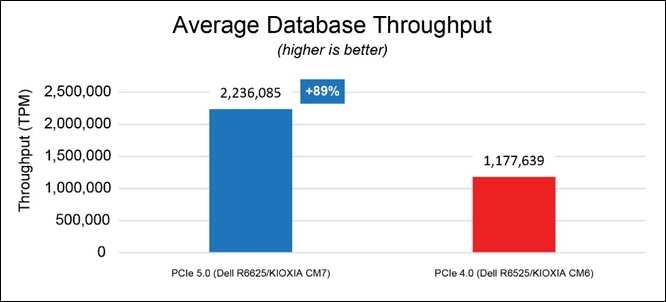
Figure 4: Average database throughput results
Average Read Latency (Figure 5).
This test measured drive read latency in milliseconds (ms) - the time it took to perform a drive read operation and included the time it took to complete the operation and receive a ‘successfully completed’ acknowledgement. These metrics were obtained from the drives while the database workload was running. Figure 5 shows the average read latency from three test runs for each set of drives - the lower result is better.
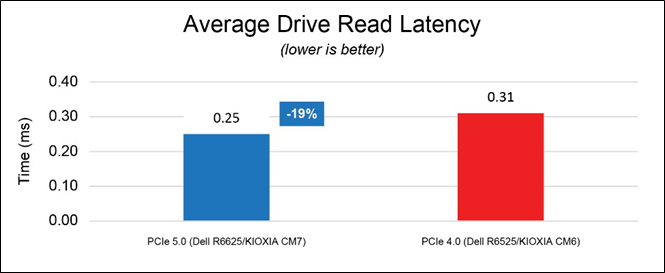
Figure 5: Average read latency results
Average Write Latency (Figure 6).
This test measured drive write latency in milliseconds (ms) - the time it took to perform a drive write operation and included the time it took to complete the operation and receive a ‘successfully completed’ acknowledgement. These metrics were obtained from the drives while the database workload was running. Figure 6 shows the average write latency from three test runs for each set of drives - the lower result is better.

Figure 6: Average write latency results
Average Server Power Consumption (Figure 7).
This test measured the average amount of power drawn by each server system in its entirety including all of the individual components that run from the server’s power supply unit (PSU). This includes the motherboard, CPU, memory, storage and other server components. The following results in Figure 7 were obtained from the Integrated Dell Remote Access Controller (iDRAC) – the results are in watts (W).
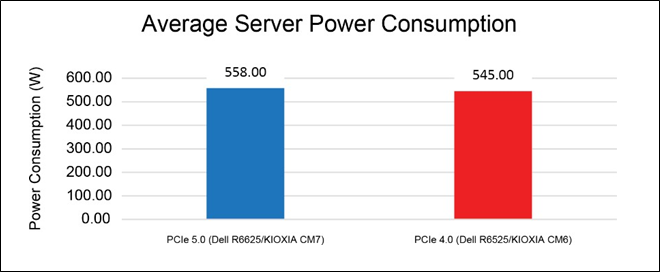
Figure 7: Average server power consumption results
Although the overall system power draw is slightly higher in the PCIe 5.0 configuration, the solution is able to maintain 89% higher database throughput, 19% lower read latency and 33% lower write latency on average.
From the Figure 7 results, database throughput per watt can be easily determined by dividing the average database throughput by the average server consumption as depicted in Figure 8 – the higher result is better.
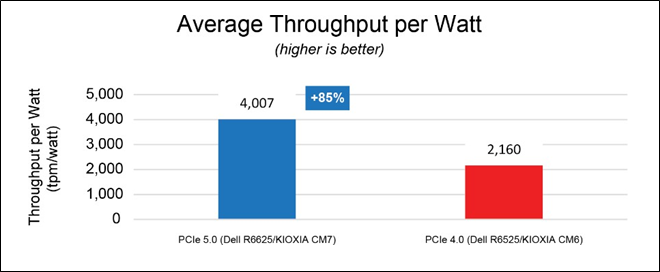
Figure 8: Average throughput per watt results
The PCIe 5.0 configuration was able to deliver 4,007 TPM per watt versus 2,160 TPM per watt delivered by the PCIe 4.0 configuration, nearly doubling database throughput per watt. At the data center level, these results enable administrators to use the same number of servers for nearly double the performance, or converse to this, scale the number of servers to help save on power consumption and total cost of ownership without sacrificing performance.
Final analysis
Next generation Dell PowerEdge 6625 Rack Servers deployed with KIOXIA CM7 Series PCIe 5.0 E3.S SSDs show nearly double the database performance when compared with a previous generation while lowering SSD latency by performing read/write operations faster. This system delivered 89% more transactions per minute enabling higher relational database workload densities while reducing the footprint of servers needed to service these workloads.
The Dell PowerEdge R6625 and KIOXIA CM7 Series SSD test configuration also demonstrated a comparable server power draw when compared with the previous generation test system. Though the active power increased from PCIe 4.0 to PCIe 5.0 by approximately 13 watts, the system was able to process almost twice as many transactions while consuming almost the same amount of power. As such, fewer servers are necessary to achieve the same level of performance without experiencing a power consumption spike.
The test results indicate that the latest 16G Dell PowerEdge 6625 Rack Servers deliver almost twice the relational database transactions using approximately the same amount of power when compared with prior PCIe generations.
Appendix A – PostgreSQL Parameters / OS Tuning Parameters
The PostgreSQL parameters used for this comparison include:
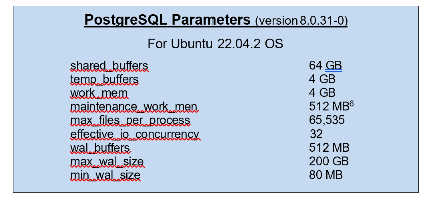
Additional tuning parameters performed on the OS to optimize system performance were made to /etc/sysctl.conf files and
/etc/security/limits.conf files. The /etc/sysctl.conf files override OS default kernel parameter values while the
/etc/security/limits.conf files allow resource limits to be set. These tuning parameters include:
/etc/sysctl.conf file changes:
Parameter | Value |
vm.swappiness | 0 |
kernel.sem | 250 32000 100 128 |
fs.file-max | 6815744 |
net.core.rmem_default | 262144 |
net.core.rmem_max | 4194304 |
net.core.wmem_default | 262144 |
net.core.wmem_max | 1048576 |
fs.aio-max-nr | 1048576 |
vm.nr_hugepages | 35000 |
/etc/security/limits.conf file changes:
User | Values | ||
* | soft | nproc | 65535 |
* | hard | nproc | 65535 |
* | soft | nofile | 65535 |
* | hard | nofile | 65535 |
root | soft | nproc | 65535 |
root | hard | nproc | 65535 |
root | soft | nofile | 65535 |
root | hard | nofile | 65535 |
postgres | soft | memlock | 100000000 |
postgres | hard | memlock | 100000000 |
References
Footnotes
- 2.5-inch indicates the form factor of the SSD and not its physical size.
- PostgreSQL is a powerful, open source object-relational database system with over 35 years of active development and a reputation for reliability, feature robustness and performance.
- The product image shown is a representation of the design model and not an accurate product depiction.
- The product image shown was provided with permission from KIOXIA America, Inc. and is a representation of the design model and not an accurate product depiction.
- Drive Write Per Day (DWPD) means the drive can be written and re-written to full capacity once a day, every day for five years, the stated product warranty period. Actual results may vary due to system configuration, usage and other factors. Read and write speed may vary depending on the host device, read and write conditions and file size.
- Definition of capacity - KIOXIA Corporation defines a megabyte (MB) as 1,000,000 bytes, a gigabyte (GB) as 1,000,000,000 bytes and a terabyte (TB) as 1,000,000,000,000 bytes. A computer operating system, however, reports storage capacity using powers of 2 for the definition of 1Gbit = 230 bits = 1,073,741,824 bits, 1GB = 230 bytes = 1,073,741,824 bytes and 1TB = 240 bytes = 1,099,511,627,776 bytes and therefore shows less storage capacity. Available storage capacity (including examples of various media files) will vary based on file size, formatting, settings, software and operating system, and/or pre-installed software applications, or media content. Actual formatted capacity may vary.
- RAID 5 is a redundant array of independent disks configuration that uses disk striping with parity - Data and parity are striped evenly across all of the disks, so no single disk is a bottleneck.
- HammerDB is benchmarking and load testing software that is used to test popular databases. It simulates the stored workloads of multiple virtual users against specific databases to identify transactional scenarios and derive meaningful information about the data environment, such as performance comparisons.
- TPROC-C is the OLTP workload implemented in HammerDB derived from the TPC-C™ specification with modification to make running HammerDB straightforward and cost-effective on any of the supported database environments. The HammerDB TPROC-C workload is an open source workload derived from the TPC-C Benchmark Standard and as such is not comparable to published TPC-C results, as the results comply with a subset rather than the full TPC-C Benchmark Standard. TPROC-C means Transaction Processing Benchmark derived from the TPC "C" specification.
- The noatime option turns off access time recording so that the file system will ignore access time updates on files. If the file system is used for database workloads, specifying noatime can reduce writes to the file system.
- The discard option allows the file system to inform the underlying block device to issue a TRIM command when blocks are longer used. KIOXIA makes no warranties regarding the test results and performance can vary due to system configuration usage and other factors.
- Read and write speed may vary depending on the host device, read and write conditions and file size.
Trademarks
AMD EPYC and combinations thereof are trademark of Advanced Micro Devices, Inc. Dell and PowerEdge are registered trademarks or trademarks of Dell Inc.
NVMe is a registered or unregistered trademark of NVM Express, Inc. in the United States and other countries. PCIe is a registered trademark of PCI-SIG.
PostgreSQL is a registered trademark of the PostgreSQL Community Association of Canada.
All other company names, product names and service names may be trademarks or registered trademarks of their respective companies.
TPC-C is a trademark of the Transaction Processing Performance Council. All other company names, product names and service names may be trademarks or registered trademarks of their respective companies.
Ubuntu is a registered trademark of Canonical Ltd.
XFS is a registered trademark of Silicon Graphics International Corp. or its subsidiaries in the United States and/or other countries.
All other company names, product names and service names may be trademarks or registered trademarks of their respective companies.
Disclaimers
© 2023 Dell, Inc. All rights reserved. Information in this tech note, including product specifications, tested content, and assessments are current and believed to be accurate as of the date that the document was published and subject to change without prior notice. Technical and application information contained here is subject to the most recent applicable product specifications.

Achieving Significant Virtualization Performance Gains with New 16G Dell® PowerEdge™ R760 Servers
Thu, 25 Jan 2024 17:43:01 -0000
|Read Time: 0 minutes
Summary
With the latest Dell PowerEdge R760 16G servers utilizing the PCIe® 5.0 interface to connect networking and storage to the CPU, there are great performance increases in data movement over previous PCIe generations. These improvements can be utilized by hyperconverged infrastructures running on these servers.
This Direct from Development (DfD) tech note presents a generational server performance comparison in a virtualized environment comparing new 16G Dell PowerEdge R760 servers deployed with new KIOXIA CM7 Series SSDs with prior generation 14G Dell PowerEdge R740xd servers deployed with prior generation KIOXIA CM6 Series SSDs.
As presented by the test results, the latest Dell generation PowerEdge servers perform the same amount of work in less time and deliver faster performance in a virtualized environment when compared with prior PCIe server generations.
Market positioning
Data center infrastructures typically fall into three categories: traditional, converged and hyperconverged. Hyperconverged infrastructures enable users to add compute, memory and storage requirements as needed, delivering the flexibility of horizontal and vertical scaling. However, many virtual machine (VM) configurations run in converged infrastructures, and their ability to scale is often difficult when VM clusters require more storage.
VMware®, Inc. enables hyperconverged infrastructures through VMware ESXi™ and VMware vSAN™ platforms. The VMware ESXi platform is a popular enterprise-grade virtualization platform that scales compute and memory as needed and provides simple management of large VM clusters. The VMware vSAN platform enables the infrastructure to transition from converged to hyperconverged, delivering incredibly fast performance since storage is local to the servers themselves. The platforms support a new VMware vSAN Express Storage Architecture™ (ESA) that has gone through a series of optimizations to utilize NVMe™ SSDs more efficiently than in the past.
Product features
Dell PowerEdge 760 Rack Server (Figure 1)
Specifications: https://www.delltechnologies.com/asset/en-us/products/servers/technical-support/poweredge-r760-spec-sheet.pdf.

Figure 1: Side angle of Dell PowerEdge 760 Rack Server1
KIOXIA CM7 Series Enterprise NVMe SSD (Figure 2) Specifications:https://americas.kioxia.com/en-us/business/ssd/enterprise-ssd.html.
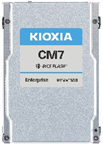
Figure 2: Front view of KIOXIA CM7 Series SSD2
PCIe 5.0 and NVMe 2.0 specification compliant; Two configurations: CM7-R Series (read intensive), 1 Drive Write Per Day3 (DWPD), up to 30,720 gigabyte4 (GB) capacities and CM7-V Series (higher endurance mixed use), 3 DWPD, up to 12,800 GB capacities.
Performance specifications: SeqRead = up to 14,000 MB/s; SeqWrite = up to 7,000 MB/s; RanRead = up to 2.7M IOPS; RanWrite = up to 600K IOPS.
Hardware/Software test configuration
The hardware and software equipment used in this virtualization comparison (Figure 3):
Server Information | ||
Server Model | Dell PowerEdge R7605 | Dell PowerEdge R740xd6 |
No. of Servers | 3 | 3 |
BIOS Version | 1.3.2 | 2.18.1 |
CPU Information | ||
CPU Model | Intel® Xeon® Gold 6430 | Intel Xeon Silver 4214 |
No. of Sockets | 2 | 2 |
No. of Cores | 64 | 24 |
Frequency (in gigahertz) | 2.1 GHz | 2.2 GHz |
Memory Information | ||
Memory Type | DDR5 | DDR4 |
Memory Speed (in megatransfers per second) | 4,400 MT/s | 2,400 MT/s |
Memory Size (in gigabytes) | 16 GB | 32 GB |
No. of DIMMs | 16 | 12 |
Total Memory (in gigabytes) | 256 GB | 384 GB |
SSD Information | ||
SSD Model | KIOXIA CM7-R Series | KIOXIA CM6-R Series |
Form Factor | 2.5-inch7 | 2.5-inch |
Interface | PCIe 5.0 x4 | PCIe 4.0 x4 |
No. of SSDs | 12 | 12 |
SSD Capacity (in terabytes4) | 3.84 TB | 3.84 TB |
Drive Write(s) Per Day (DWPD) | 1 | 1 |
Active Power | 25 watts | 19 watts |
Operating System Information | ||
Operating System (OS) | VMware ESXi | VMware ESXi |
OS Version | 8.0.1, 21813344 | 8.0.1, 21495797 |
VMware vCenter® Version | 8.0.1.00200 | 8.0.1.00200 |
Storage Type | vSAN ESA | vSAN ESA |
Load Generator Information (Test Software) | ||
Load Generator | HyperConverged Infrastructure Benchmark (HCIBench) | HCIBench |
Load Generator Version | 2.8.2 | 2.8.2 |
Figure 3: Hardware/Software configuration used in the comparison
Set-up and test procedures
Set-up:
The latest VMware ESXi 8.0 operating system was installed on all hosts.
Two clusters were created in VMware’s vCenter management interface with ‘High Availability’ and ‘Distributed Resource Scheduler’ disabled for testing.
Each Dell PowerEdge R760 host was added into a cluster - then each Dell PowerEdge R740xd host was added into a separate cluster.
VMkernel adapters were set up to have VMware vMotion™ migration, provisioning, management and the VMware vSAN platform enabled for both test configurations.
In the VMware vSAN configurations, twelve KIOXIA CM7 Series drives were added for the Dell PowerEdge R760 cluster (four drives per server), and twelve KIOXIA CM6 Series drives were added for the Dell PowerEdge R740xd cluster (four drives per server). The default storage policy was set to ‘vSAN ESA Default Policy – RAID 5’ for both configurations.
The HCIBench load generator (virtual appliance) was then imported and configured on the network.
Test procedures:
The latest VMware ESXi 8.0 operating system was installed on all hosts.
Six tests were run on each cluster – four performance tests and two power consumption tests as follows:
Performance tests:
IOPS: This metric measured the number of Input/Output operations per second that the system completed. Throughput: This metric measured the amount of data transferred per second to and from the storage devices.
Read Latency: This metric measured the time it took to perform a read operation. It included the average time it took for the load generator to not only issue the read operation, but also the time it took to complete the operation and receive a ‘successfully completed’ acknowledgement.
Write Latency: This metric measured the time it took to perform a write operation. It included the average time it took for the load generator to not only issue the write operation, but also the time it took to complete the operation and receive a ‘successfully completed’ acknowledgement.
Power consumption tests:
IOPS per Watt: This metric measured the amount of IOPS performed in conjunction with the power consumed by the cluster.
Throughput per Watt: This metric measured the amount of throughput performed in conjunction with the power consumed by the cluster.
For the four performance tests, the following five workloads were run with the test results recorded. For the two power consumption tests, the latter four workloads were run with the test results recorded.
100% Sequential Write (256K block size, 1 thread): This workload is representative of a data logging use case. 100% Random Read (4K block size, 4 threads): This workload is representative of a read cache system.
Random 70% Read / 30% Write (4K block size, 4 threads): This workload is representative of a common mixed read/write ratio used in commercial database systems.
Random 50% Read /50% Write (4K block size, 4 threads): This workload is representative of other common IT use cases such as email.
Blender (block sizes/threads vary): This workload is representative of a mix of many types of sequential and random workloads at various block sizes and thread counts as VMs request storage against the vSAN storage pool.
Test results8
IOPS (Figure 4): The results are in IOPS - the higher result for each is better.
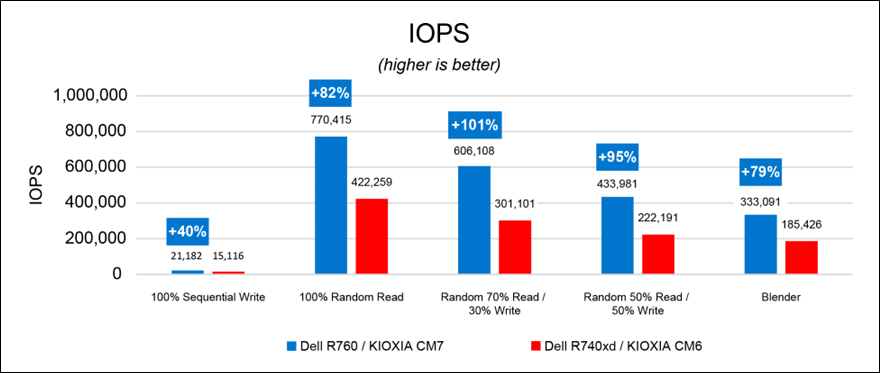
Figure 4: IOPS results
Throughput (Figure 5): The results are in megabytes per second (MB/s) - the higher result for each is better.
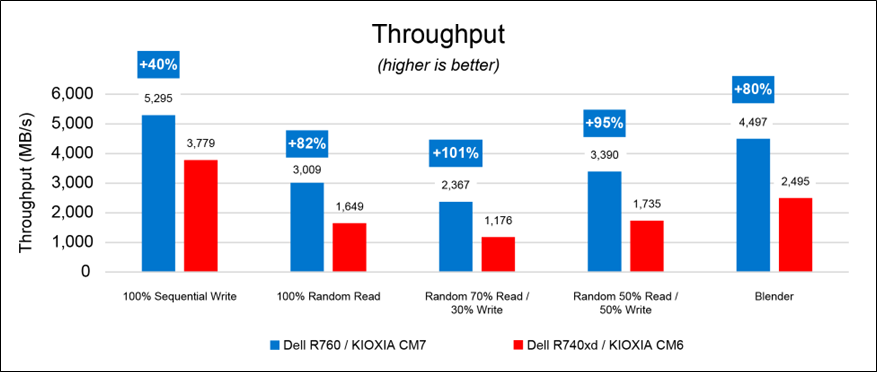
Figure 5: throughput results
Read Latency (Figure 6): The results are in milliseconds (ms) - the lower result for each is better. The 100% sequential write workloads for both configurations were not included for this test as the workload does not include read operations.
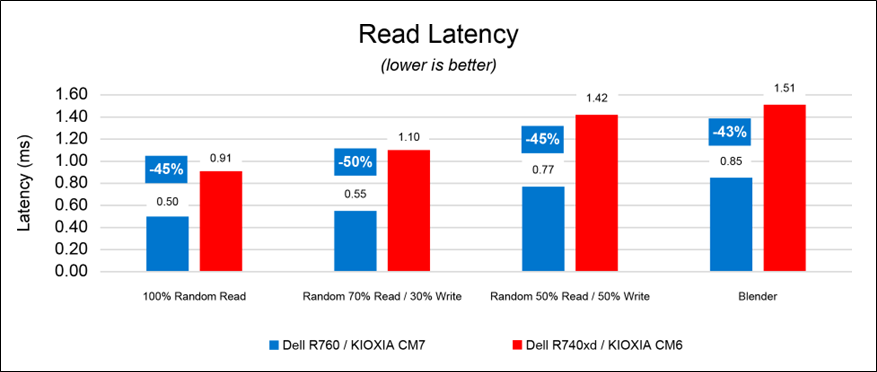
Figure 6: read latency results
Write Latency (Figure 7): The results are in milliseconds - the lower result for each is better. The 100% random read workloads for both PCIe configurations were not included for this test as the workload does not include write operations.

Figure 7: write latency results
IOPS per Watt (Figure 8): The results show the amount of IOPS performed per power consumed by the cluster and are in IOPS per watt (IOPS/W). The higher result for each is better.
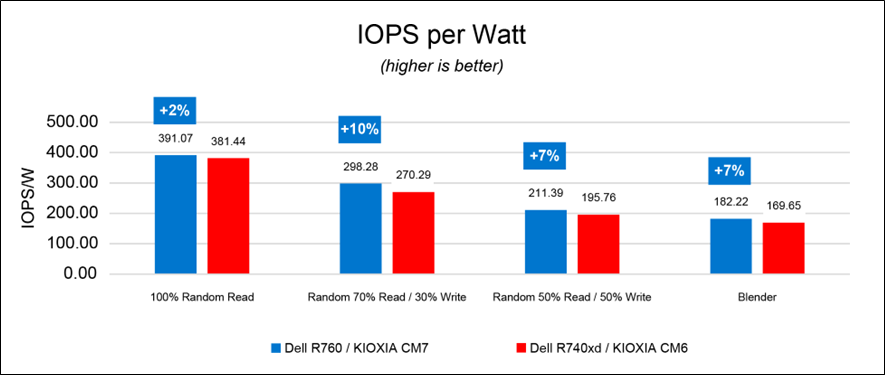
Figure 8: IOPS per watt results
Throughput per Watt (Figure 9): The results show the amount of throughput performed per power consumed by the cluster and are in MB/s per watt (MBps/W). The higher result for each is better.
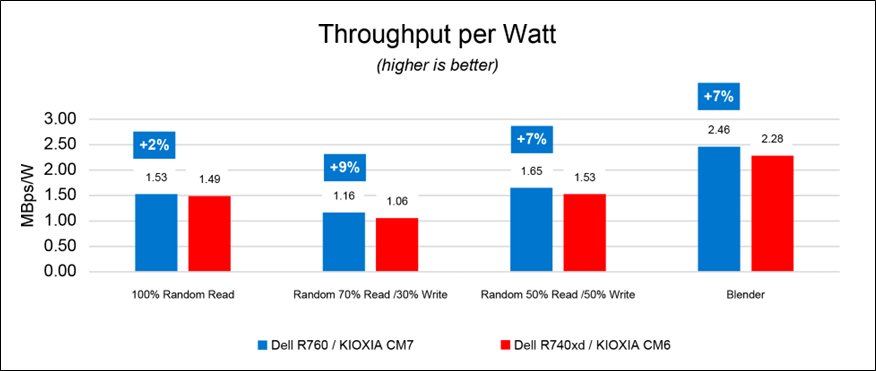
Figure 9: throughput per watt results
Final analysis
The Dell PowerEdge R760 servers equipped with new KIOXIA CM7 Series enterprise NVMe SSDs outperformed the Dell PowerEdge 740xd servers and SSDs in IOPS, throughput and latency. They also delivered higher performance per watt. With the newer generation of Dell PowerEdge servers, there are notable performance increases associated with hyperconverged infrastructures that directly affect server, CPU, memory and storage performance when compared with prior generations.
References
Footnotes
1. The product image shown is a representation of the design model and not an accurate product depiction.
2. The product image shown was provided with permission from KIOXIA America, Inc. and is a representation of the design model and not an accurate product depiction.
3. Drive Write Per Day (DWPD) means the drive can be written and re-written to full capacity once a day, every day for five years, the stated product warranty period. Actual results may vary due to system configuration, usage and other factors. Read and write speed may vary depending on the host device, read and write conditions and file size.
4. Definition of capacity - KIOXIA Corporation defines a megabyte (MB) as 1,000,000 bytes, a gigabyte (GB) as 1,000,000,000 bytes and a terabyte (TB) as 1,000,000,000,000 bytes. A computer operating system, however, reports storage capacity using powers of 2 for the definition of 1Gbit = 230 bits = 1,073,741,824 bits, 1GB = 230 bytes = 1,073,741,824 bytes and 1TB = 240 bytes = 1,099,511,627,776 bytes and therefore shows less storage capacity. Available storage capacity (including examples of various media files) will vary based on file size, formatting, settings, software and operating system, and/or pre-installed software applications, or media content. Actual formatted capacity may vary.
5. The Dell PowerEdge R760 server features a PCIe 4.0 backplane.
6. The Dell PowerEdge R740xd server features a PCIe 3.0 backplane.
7. 2.5-inch indicates the form factor of the SSD and not its physical size.
8. Read and write speed may vary depending on the host device, read and write conditions and file size.
Trademarks
Dell and PowerEdge are registered trademarks or trademarks of Dell Inc.
Intel and Xeon are registered trademarks of Intel Corporation or its subsidiaries in the U.S. and/or other countries NVMe is a registered or unregistered trademark of NVM Express, Inc. in the United States and other countries. PCIe is a registered trademark of PCI-SIG.
VMware, VMware ESXi, VMware vMotion, VMware vSAN, VMware vSAN Express Storage Architecture and VMware vCenter are registered trademarks or trademarks of VMware Inc. in the United States and/or various jurisdictions.
All other company names, product names and service names may be trademarks or registered trademarks of their respective companies.
Disclaimers
© 2023 Dell, Inc. All rights reserved. Information in this tech note, including product specifications, tested content, and assessments are current and believed to be accurate as of the date that the document was published and subject to change without prior notice. Technical and application information contained here is subject to the most recent applicable product specifications.

New SAP HANA World Record with 5th Generation Intel® Xeon® Processors
Fri, 15 Dec 2023 19:13:37 -0000
|Read Time: 0 minutes
Dell just announced performance upgrades for PowerEdge, including the R660 and R760. In fact, according to the SAP Performance Benchmark, the PowerEdge R760 with the new 5th Generation Intel® Xeon® Scalable processor delivered outstanding SAP HANA performance in two categories, including a result with 2.6B initial records that sets a new World Record!
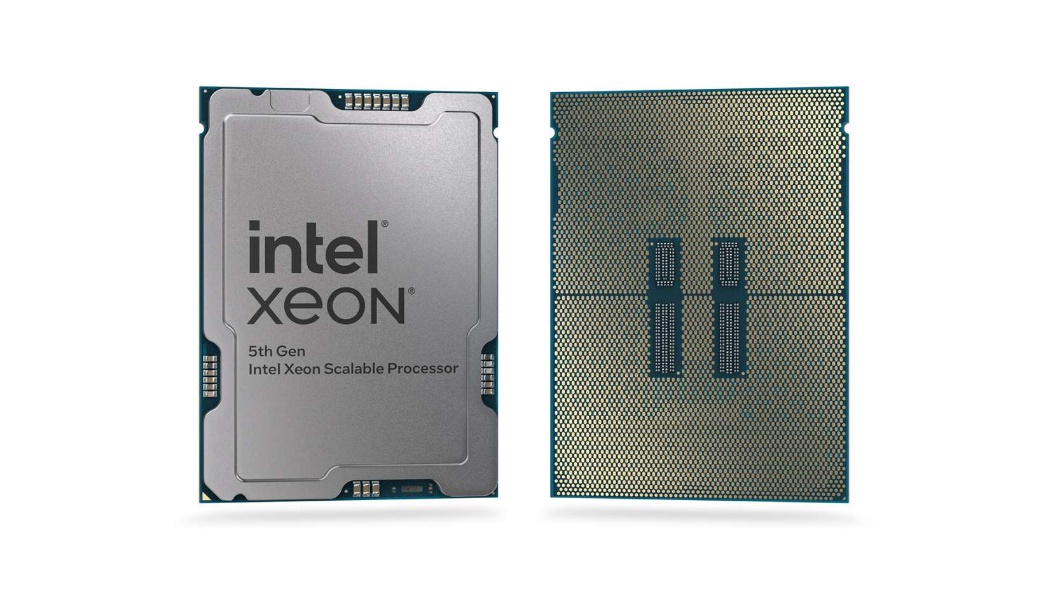

Check out the PowerEdge R760 Rack Server page for more information.
Author: Seamus Jones, Director, Server Technical Marketing Engineering

Insights on Cloudera Data Platform on VMware Cloud Foundation Powered by VMware vSAN
Thu, 05 Oct 2023 19:34:38 -0000
|Read Time: 0 minutes
Summary
This joint paper outlines a brief discussion on the key hardware considerations when configuring a successful deployment and recommends configurations based on 15th Generation PowerEdge Server.
Market positioning
VMware Cloud Foundation is built on VMware’s leading hyperconverged architecture, VMware vSAN, with all-flash performance and enterprise-class storage services including deduplication, compression, and erasure coding. vSAN implements hyperconverged storage architecture by delivering an elastic storage and simplifying the storage management.
VMware vSAN is the market leader in hyperconverged Infrastructure (HCI), enabling low cost and high-performance next-generation HCI solutions. It converges traditional IT infrastructure silos onto industry-standard servers, virtualizes physical infrastructure to help customers easily evolve their infrastructure without risk, improves TCO over traditional resource silos, and scales to tomorrow with support for new hardware, applications, and cloud strategies.
Cloudera Data Platorm (CDP) Private Cloud Base supports a variety of hybrid solutions where compute tasks are separated from data storage and where data can be accessed from remote clusters, including workloads created using CDP Private Cloud Experiences. This hybrid approach provides a foundation for containerized applications by managing storage, table schema, authentication, authorization, and governance.
Key Considerations
- Often, enterprises have at least a development CDP cluster, a preproduction staging CDP cluster, and a production cluster. With virtualization, there is the flexibility to share the hardware for these Hadoop clusters. The CDP version for the development cluster is likely more current than that of the others because developers like to work with the newer versions. Dedicating a set of hardware to one version of a Hadoop vendor’s product does not make the best use of resources.
- Co-locating CDP VMs on host servers with VMs supporting different workloads is also possible, particularly for situations that are not performance critical. Doing this can balance the use of the system. This often enables better overall utilization by consolidating applications that either use different kinds of hardware resources or use the hardware resources at different times of the day or night.
- Efficiency: VMware enables easy and efficient deployment of CDP on an existing virtual infrastructure as well as consolidation of otherwise dedicated CDP cluster hardware into a data center or cloud environment.
- Availability and fault tolerance: vSphere features such as VMware vSphere High Availability (vSphere HA) and VMware vSphere Fault Tolerance (vSphere FT) can protect the CDP components from server failure and improve availability. Resource management tools such as VMware vSphere vMotion can provide availability during planned server downtime and maintenance windows.
Available Configurations
| Cloudera Data Platform on VMware Cloud Foundation (VCF) with vSAN |
| ||
| VCF Management Domain 4 nodes required
| VCF Workload Domain for Cloudera Data Platform Base
4 (minimum) up to 64 nodes per workload domain Up to 15 workload domains (including management domain)
|
| |
Platform | PowerEdge R650 supporting 10 NVMe drives (direct), or VxRail E660N |
| ||
CPU | 2x Intel® Xeon® Gold 5318Y processor (2.1GHz, 24 cores) | 2x Intel Xeon Gold 6348 processor (2.6GHz, 28 cores 4 GHz)
|
| |
DRAM | 256GB (16x 16GB DDR4-3200) or more | 512 GB (16 x 32 GB DDR4-3200) or more |
| |
Boot Device | Dell BOSS-S2 with 2x 240GB or 2x 480GB M.2 SATA SSD (RAID1) |
| ||
Cache tier Drives | 2x 400GB Intel Optane P5800X (PCIe Gen4) |
| ||
Capacity tier Drives (1) | 6x (up to 8x) 1.92TB Enterprise NVMe Read Intensive AG Drive U.2 Gen4 | 8x 1.92TB or 3.84TB Enterprise NVMe Read Intensive AG Drive U.2 Gen4 |
| |
Network Interface Controller | Intel E810-XXVDA2 for OCP3 (dual-port 25Gb) | Intel E810-XXVDA2 for OCP3 (dual-port 25Gb), or Intel E810-CQDA2 PCIe (dual-port 100Gb) |
| |
Note: For more than 7 workload domains, each node needs a minimum of 512GB DRAM (16x 32GB) and more capacity (use 3.84TB drives instead of 1.92TB).
This solution can be deployed on either Dell PowerEdge based vSAN ReadyNodes or VxRail appliances.
Solution adopted from https://core.vmware.com/resource/cloudera-data-platform-vmware-cloud-foundation-powered-vmware-vsan.
For more information and specifications, contact a Dell representative. Alternative storage configurations can be considered.
Authors: Todd Mottershead (Dell), Seamus Jones (Dell), Esther Baldwin (Intel), Krzysztof Cieplucha (Intel), Teck Joo (Intel), Amandeep Raina (Intel), and Patryk Wolsza (Intel)

Improving Oracle Performance with New Dell 4 Socket Servers
Mon, 02 Oct 2023 21:23:14 -0000
|Read Time: 0 minutes
Deploying Oracle on a PowerEdge Server presents various challenges, typical of intricate software and hardware integrations. As servers age, they become increasingly expensive to maintain and can have detrimental effects on business productivity. This is primarily due to the heightened demand for IT personnel's time and the heightened risk of unscheduled downtime.
In the case of older servers hosting virtualized Oracle® Database applications, they might struggle to keep up with growing usage demands. This can result in slower operations that, for example, dissuade customers from browsing a website for products and completing online transactions. Aging hardware is also more susceptible to data loss or corruption, potential security vulnerabilities, and elevated maintenance and repair expenses.
One effective solution to address these issues is migrating Oracle Database workloads from older servers to newer ones, such as the 16th Generation Dell™ PowerEdge™ R960 featuring 4th Gen Intel® Xeon® Scalable processors. This upgrade not only mitigates the aforementioned concerns but also opens doors to further IT enhancements and facilitates the achievement of business objectives. It can lead to improved customer responsiveness and quicker time-to-market.
Additionally, transitioning workloads from virtualized environments to bare metal solutions has the potential to significantly enhance transactional database performance, particularly for databases that come with high-performance service-level agreements (SLAs).
We recently submitted one of the new Dell PowerEdge R960’s to Principled Technologies for testing with an Oracle database 19c and compared the results to previous generations. The performance exceeded even our own lofty expectations. As the graph below shows, the R960 was able to process almost 8 times more transactions than the PowerEdge R920 and over double the transactions of the previous generation PowerEdge R940.

For more details read the full report here: Improving Oracle Database performance: Moving to Dell PowerEdge R960 servers with Intel processors | Dell Technologies Info Hub
When refreshing platforms it is critical to consider these performance characteristics and other common top 10 concerns such as:
- Compatibility Issues: Ensuring that the version of Oracle Database you want to deploy is compatible with the specific PowerEdge server hardware, operating system, and other software components can be a significant challenge. Compatibility matrices provided by Oracle and Dell (the manufacturer of PowerEdge servers) need to be thoroughly reviewed.
- Hardware Selection: Selecting the right PowerEdge server model with the appropriate CPU, memory, storage, and networking capabilities to meet the performance and scalability requirements of Oracle can be tricky. Overestimating or underestimating these requirements can lead to performance bottlenecks or wasted resources.
- Operating System Configuration: Configuring the operating system (typically, a Linux distribution like Oracle Linux or Red Hat Enterprise Linux) to meet Oracle's specific requirements can be complex. This includes setting kernel parameters, file system configurations, and installing necessary packages.
- Storage Configuration: Setting up storage correctly is critical for Oracle databases. Customers need to configure RAID levels, partitioning, and file systems optimally. Ensuring high I/O throughput and low latency is essential for database performance.
- Network Configuration: Proper network configuration, including setting up the network stack and configuring firewalls, is important for database security and accessibility.
- Oracle Database Configuration: Configuring Oracle Database itself, including memory allocation, database parameters, and storage management, requires a deep understanding of Oracle's architecture and best practices. Misconfigurations can lead to poor performance and stability issues.
- Backup and Recovery Strategy: Developing a robust backup and recovery strategy is crucial to protect the database against data loss. This includes configuring Oracle Recovery Manager (RMAN) and ensuring that backups are performed regularly and can be restored successfully.
- High Availability and Disaster Recovery: Implementing high availability and disaster recovery solutions, such as Oracle Real Application Clusters (RAC) or Data Guard, can be complex and requires careful planning and testing.
- Licensing and Compliance: Managing Oracle licenses and ensuring compliance with Oracle's licensing policies can be challenging, especially in virtualized or clustered environments.
- Performance Tuning: Continuously monitoring and tuning the Oracle database and the underlying PowerEdge server to optimize performance can be an ongoing challenge. This includes identifying and addressing performance bottlenecks and ensuring that the hardware is used efficiently.
To address these challenges, it is often advisable for customers to work with experienced system administrators, database administrators, and consultants who have expertise in both Oracle and PowerEdge server deployments. Additionally, staying informed about the latest updates, patches, and best practices from Oracle and Dell can help mitigate potential issues all of which can be found by partnering with Dell Technologies to take advantage of these performance enhancements found within the PowerEdge R960.
Author: Seamus Jones
Director, Server Technical Marketing Engineering

Extracting Insights on a Scalable and Security-Enabled Data Platform from Cloudera
Fri, 14 Jul 2023 19:48:55 -0000
|Read Time: 0 minutes
Summary
This joint paper outlines a brief discussion on the key hardware considerations when configuring a successful deployment and recommends configurations based on the most recent PowerEdge Server portfolio offerings.
Market positioning
Cloudera Data Platform (CDP) Private Cloud is a scalable data platform that allows data to be managed across its lifecycle—from ingestion to analysis—without leaving the data center. It comprises two products: Cloudera Private Cloud Base (the on-premises portion built on Dell PowerEdge servers) and Cloudera Private Cloud Data Services. The Data Services provide containerized compute analytics applications that scale dynamically and can be upgraded independently. This platform simplifies managing the growing volume and variety of data in your enterprise, and unleashes the business value of that data. By disaggregating compute and storage, and supporting a container based environment, CDP Private cloud helps enhance business agility and flexibility. The platform also includes secure user access and data governance features.
Key considerations
- Data throughput - CDP Private Cloud on Dell PowerEdge servers is built on high-performing Intel architecture. Intel® Ethernet network controllers, adapters, and accessories enable agility in the data center and support high throughput. Unlike many other point solutions, CDP Private Cloud is an end-to-end platform for data, from collecting and engineering to reporting and using AI capabilities.
- Balanced system configuration - CDP Private Cloud can handle multiple varying workloads, including analytics and machine learning (ML). Its capabilities are supported by generation-over-generation improvements in underlying Intel technologies that offer more cores and higher memory capacity.
- Data latency - As data grows and needs to be accessed across the cluster, data-access response times are critical, especially for real-time analytics applications.
Available configurations
Table 1. Cloudera Data Platform (CDP) Private Cloud Base Cluster
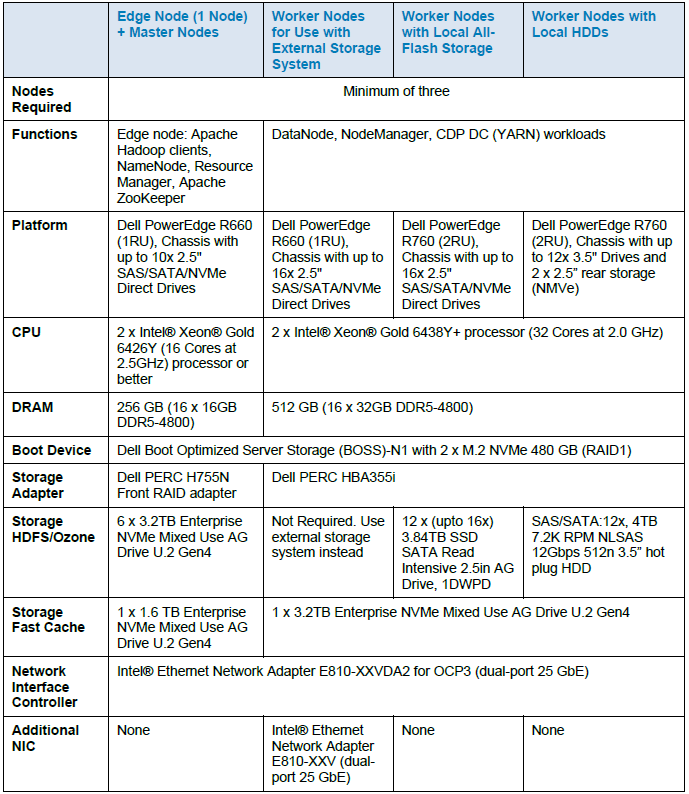
Note: For a storage-only configuration (HDFS/Ozone), customers can still choose traditional high-density storage nodes with high-capacity rotational HDDs based on the PowerEdge R740xd2 platform, although external storage systems, such as Dell PowerScale or Dell ECS, are recommended. Customers should be aware that using large capacity HDDs increases the time of background scans (bit-rot detection) and block report generation for HDFS. It also significantly increases recovery time after a full node failure. Also, using nodes with more than 100 TB of storage is not recommended by Cloudera. Source: https://blog.cloudera.com/disk-and-datanode-size-in-hdfs/. For more information and specifications, contact a Dell representative.
Table 2. CDP Private Cloud Data Services (Red Hat OpenShift Kubernetes)/Embedded Container Service (ECS) Cluster
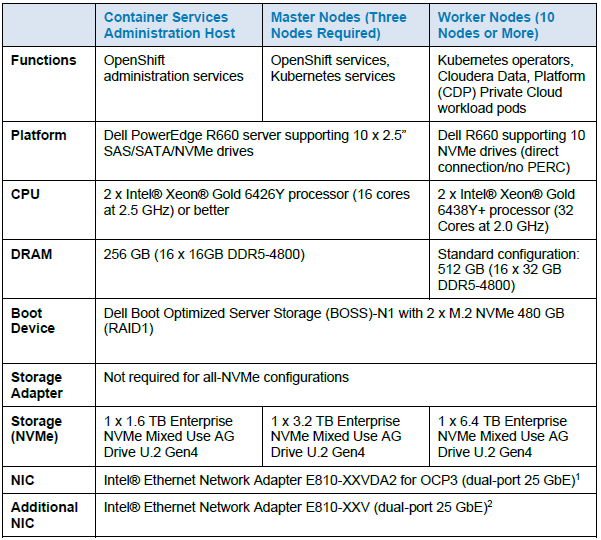
Learn more
Contact your Dell Technologies or Intel account team for a customized quote 1-877-289-3355.
Note: This document may contain language from third-party content that is not under Dell Technologies’ control and is not consistent with current guidelines for Dell Technologies’ own content. When such third-party content is updated by the relevant third parties, this document will be revised accordingly.

On the record for Sapphire: World Record SAP HANA Performance with Dell PowerEdge R760 Servers
Wed, 17 May 2023 15:19:25 -0000
|Read Time: 0 minutes

SAP HANA is an in-memory database platform used to manage large amounts of data in real time for purposes such as point-of-sale data, real-time analytics for inventory management, supply-chain optimization, and customer behavior analysis. As the amount of data that must be processed grows, servers can be challenged to deliver information and analysis quickly enough to meet the increasingly demanding business requirements for fast data access. That is why SAP HANA users are always on the lookout for better-performing servers.
SAP publishes the results of standardized benchmark tests to assist customers in comparing the performance of different servers when running SAP HANA. Performance results for the Dell PowerEdge R760 server were recently published, and we are excited to share some highlights about how well this server stacks up against other servers.
Fifteen different data points are available for comparing the PowerEdge R760 server to other servers. The standard benchmarks measure three key performance data points for each of the five different database sizes on which the PowerEdge R760 server was tested.
The following table shows the rank of the PowerEdge R760 server for each of the 15 points of comparison among all the different servers tested using SAP’s benchmark version 3. The source of the data is the publicly available SAP Standard Application Benchmarks directory, accessed on 04-19-2023.

The PowerEdge R760 server outperformed all the other servers in 13 of the 15 benchmark points of comparison, and it ranked second in the remaining two.
The PowerEdge R760 server is a two-socket server built with the latest 4th Gen Intel Xeon Scalable processors. It outperforms all other servers in SAP HANA benchmarking—even 4 and 8-socket servers—in every database size of up to 6.5 billion initial records. It provides the performance and versatility to address your most demanding applications, including SAP HANA, with massive databases and mission-critical requirements for real-time performance.
Look for an in-depth study from Prowess: Remarkable SAP Benchmark Performance Results for Dell PowerEdge R760 Servers (delltechnologies.com) about how the PowerEdge R760 server performed against top competitors on the SAP Standard Application Benchmarks.
Learn more about PowerEdge servers and Dell Technologies solutions for SAP.
About the Author:
Seamus Jones
Director, Server Technical Marketing
Seamus serves Dell as Director of Server Technical Marketing, seasoned with over 20 years of real-world experience in both North America and EMEA. His unique perspective comes from experience consulting customers on data center initiatives and server virtualization strategies.


Scaling and Optimizing ML in Enterprises
Tue, 16 May 2023 19:53:46 -0000
|Read Time: 0 minutes
Summary
This joint paper, written by Dell Technologies, in collaboration with Intel®, describes the key hardware considerations when configuring a successful MLOps deployment and recommends configurations based on the most recent 15th Generation Dell PowerEdge Server portfolio offerings.
Today’s enterprises are looking to operationalize machine learning to accelerate and scale data science across the organization. This is especially the case as their needs grow to deploy, monitor, and maintain data pipelines and models. Cloud native infrastructure, such as Kubernetes, offers a fast and scalable means to implement Machine Learning Operations (MLOps) by using Kubeflow, an open source platform for developing and deploying Machine Learning (ML) pipelines on Kubernetes.
Dell PowerEdge R650 servers with 3rd Generation Intel® Xeon® Scalable processors deliver a scalable, portable, and cost-effective solution to implement and operationalize machine learning within the Enterprise organization.
Key Considerations
- Portability. A single end-to-end platform to meet the machine learning needs of various use cases, including predictive analytics, inference, and transfer learning.
- Optimized performance. High-performance 3rd Generation Intel® Xeon® Scalable processors optimize performance for machine learning algorithms using AVX-512. Intel® performance optimizations that are built into Dell PowerEdge servers can help fine-tune large Transformers models across multi-node systems. These work in conjunction with open-source cloud native MLOps tools. Optimizations include Intel® and open-source software and hardware technologies such as Kubernetes stack, AVX-512, Horovod for distributed training, and Tensorflow 2.10.0.
- Scalability. As the machine learning workload grows, additional compute capacity needs to be added to the cloud native infrastructure. Dell PowerEdge R750 servers with 3rd Generation Intel® Xeon® Scalable processors deliver an efficient and scalable approach to MLOps.
Recommended Configurations
Cluster | ||
| Control Plane Nodes (Three Nodes Required) | Data Plane Nodes (4 Nodes or More) |
Functions | Kubernetes services | Develop, Deploy, Run Machine Learning (ML) workflows |
Platform | Dell PowerEdge R650 up to 10x 2.5” NVMe Direct Drives | |
CPU | 2x Intel® Xeon® Gold 6326 processor (16 cores @ 2.9GHz), or better | 2x Intel® Xeon® Platinum 8380 processor (40 cores at 2.3 GHz), or 2x Intel® Xeon® Platinum 8368 processor (38 cores @ 2.4GHz), or Intel® Xeon® Platinum 8360Y processor (36 cores @ 2.4GHz) |
DRAM | 128 GB (16x 8 GB DDR4-3200) | 512 GB (16x 32 GB DDR5-4800) |
Boot device | Dell Boot Optimized Server Storage (BOSS)-S2 with 2x 240GB or 2x 480 GB Intel® SSD S4510 M.2 SATA (RAID1) | |
Storage adapter | Not required for all-NVMe configuration. | |
Storage (NVMe) | 1x 1.6TB Enterprise NVMe Mixed- Use AG Drive U.2 Gen4 | 1x 1.6TB (or larger) Enterprise NVMe Mixed-Use AG Drive U.2 Gen4 |
NIC | Intel® E810-XXVDA2 for OCP3 (dual-port 25GbE) | Intel® E810-XXVDA2 for OCP3 (dual-port 25GbE), or Intel® E810-CQDA2 PCIe (dual-port 100Gb) |
Resources
Visit the Dell support page or contact your Dell or Intel account team for a customized quote 1-877-289-3355.

Securing Critical AI Solutions with Fortanix
Tue, 17 Jan 2023 08:43:16 -0000
|Read Time: 0 minutes
Summary
This joint paper, written by Dell Technologies in collaboration with Intel, outlines the key components of the Intel® Security Solution for Fortanix Confidential AI and the available configurations based on the latest generation of Dell PowerEdge servers.
Introduction
Cybersecurity has become more tightly integrated into business objectives globally, with zero trust security strategies being established to ensure that the technologies being implemented to address business priorities are secure.
Organizations need to accelerate business insights and decision intelligence more securely as they optimize the hardware-software stack. In fact, the seriousness of cyber risks to organizations has become central to business risk as a whole, making it a board-level issue.
Data is your organization’s most valuable asset, but how do you secure that data in today’s hybrid cloud world? How do you keep your sensitive data or proprietary machine learning (ML) algorithms safe with hundreds of virtual machines (VMs) or containers running on a single server?
The Intel® Security Solution for Fortanix Confidential AI, built in collaboration with Fortanix and Dell Technologies, helps contribute to your zero trust security strategy. It is an enterprise-level, high-performance, security-enabled solution that encrypts data while it is in use by isolating data and code in Intel® Software Guard Extension (Intel® SGX) enclaves, without changing underlying software applications.
Key components
- Intel® Software Guard Extensions (Intel® SGX)—A set of security-related instruction codes that isolates software and data from the underlying infrastructure (hardware or operating system) in hardware enclaves. Intel® SGX helps defend against common software-based attacks and helps protect intellectual property (like models) from being accessed and reverse-engineered by hackers or cloud providers.
- Fortanix Confidential Computing Manager—A comprehensive turnkey solution that manages the entire confidential computing environment and enclave life cycle. No application rewriting is required. Fortanix Confidential Computing Manager manages and enforces security policies including identity verification, data access control, and attestation.
- Fortanix Confidential AI—An easy-to-use subscription service that provisions security-enabled infrastructure and software to orchestrate on-demand AI workloads for data teams with a click of a button. Data teams can operate on sensitive datasets and AI models in a confidential compute environment supported by Intel® SGX enclave, with the cloud provider having no visibility into the data, algorithms, or models.
- Dell PERC H755N NVM Express (NVMe) RAID controller with self-encrypting drives (SEDs)—A RAID controller that provides additional security for stored data. Whether drives are lost, stolen, or failed, unauthorized access is prevented by rendering the drive unreadable without the encryption key within the storage controller. The PERC H755N controller offers additional benefits including regulatory compliance and secure decommissioning. It supports local key management (LKM) and external key management systems through Dell OpenManage Secure Enterprise Key Manager (SEKM).
Solution benefits
The Intel® Security Solution for Fortanix Confidential AI enables confidential computing so that AI models and data can be shared without exposing intellectual property and sensitive data. This solution:
- Delivers a turnkey, enterprise-level, and high-performance security solution without requiring application modifications
- Addresses time-to-market concerns by providing a validated solution with an installation guide, containerized tools, and sample workloads
Whether you are deploying on-premises in the cloud, or at the edge, it is increasingly critical to protect data and maintain regulatory compliance. Accelerate performance across the fastest-growing workload types in AI, analytics, networking, storage and HPC, and help protect your business and innovate with confidence.
Available configurations
Table 1. Intel® Security Solution for Fortanix Confidential AI configurations
Component | Base configuration | Plus configuration* |
Platform | Dell PowerEdge R650 1U rack server, supporting up to 8 NVMe drives in RAID configuration | |
CPU | 2 x Intel® Xeon® Gold 6348 (28 cores at 2.6 GHz) with 64 GB/CPU Intel® SGX enclave capacity | 2 x Intel® Xeon® Platinum 8368 (38 cores at 2.4 GHz) with 512 GB/CPU Intel® SGX enclave capacity |
DRAM | 256 GB (16 x 16 GB DDR4-3200) | 512 GB (16 x 32 GB DDR4-3200) (supports options up to 4 TB) |
Boot device | Dell Boot Optimized Server Storage (BOSS)-S2 with 2 x 480 GB M.2 Serial ATA (SATA) (RAID 1) | |
Storage adapter | Dell PERC H755N front NVMe RAID controller | |
Storage | 2 x (up to 8 x) 1.6 TB Enterprise NVMe Mixed Use AG SED Drive, U2 Gen4 | |
NIC | Intel® Ethernet Network Adapter E810-XXV for OCP3 (dual-port 25 Gb) | |
* Larger enclave capacity for securing bigger AI models and end-to-end AI workloads
Learn More
Contact your Dell or Intel account team for a customized quote. 1-877-ASK-DELL.

Powering Your Elasticsearch on Kubernetes
Tue, 17 Jan 2023 08:32:07 -0000
|Read Time: 0 minutes
Summary
This joint paper, written by Dell Technologies, in collaboration with Intel®, describes the key hardware considerations when configuring a successful Elasticsearch deployment and recommends configurations based on the most recent 15th Generation PowerEdge Server portfolio offerings.
Elasticsearch is a distributed, open-source search and analytics engine for all types of data, including textual, numerical, geospatial, structured, and unstructured. This proposal contains recommended configurations for Elasticsearch clusters on the Kubernetes platform (Red Hat OpenShift Container Platform with Elastic Cloud on Kubernetes (ECK) operator) running on 15th Generation Dell PowerEdge with 3rd Generation Intel® Xeon® Scalable processors (Ice Lake).
Key Considerations
- Faster and scalable performance. Elasticsearch running on the latest Dell PowerEdge servers is built on high- performing Intel® architecture and configured with 3rd Generation Intel® Xeon® Scalable processors. Indexing is faster and capacity can scale with your needs.
- Index more data. Elasticsearch can handle and store more data by increasing DRAM capacity and using PCIe Gen 4 NVMe disk drives attached to Dell PowerEdge servers.
- Reduced search times and increased # of concurrent searches. As data grows and needs to be accessed across the cluster, data-access response times are critical, especially for real-time analytics applications. Elasticsearch, running on the latest Dell PowerEdge servers, is built on high-performing Intel® architecture. Intel® Ethernet network controllers, adapters, and accessories enable agility in the data center and support high throughput and low latency response times.
- Easy and secure installation. The Elastic Cloud on Kubernetes (ECK) operator is an official Elasticsearch operator certified on Red Hat OpenShift Container Platform, providing easy deployment, management, and operation of Elasticsearch, Kibana, APM Server, Beats, and Enterprise Search on OpenShift clusters. Elasticsearch clusters deployed using this operator are secure by default (with enabled encryption and strong passwords).
- Multi Data Tiers. As data grows, costs do not have to. With multiple tiers of data, capacity can extend, and storage costs can be driven lower without performance loss. Each capacity layer can be scaled independently by using larger drives or mode nodes (or both), depending on customer needs.
Available Configurations
Elasticsearch cluster on Kubernetes (Red Hat OpenShift Kubernetes) platform | ||||
| OpenShift Control Plane Master Nodes (three nodes required) | Elasticsearch Master / Ingest / Hot tier data nodes (minimum of three nodes required) |
Elasticsearch Warm tier data nodes (optional) |
Elasticsearch Cold tier data nodes (optional) |
Functions |
OpenShift services, Kubernetes services | Elasticsearch roles: master, ingest, hot tier data Additional services, such as Kibana |
Elasticsearch roles: warm tier data |
Elasticsearch roles: cold tier data |
Platform |
Dell PowerEdge R650 chassis with up to 10x2.5” NVMe Direct Drives | Dell PowerEdge R750 chassis with up to 12x3.5” HDD with RAID | ||
CPU | 2 x Intel® Xeon® Gold 6326 processor (16 cores @ 2.9GHz) or better |
2 x Intel® Xeon® Gold 6338 processor (32 cores @ 2.0GHz) |
2 x Intel® Xeon® Gold 5318Y processor (24 cores @ 2.1GHz) |
2 x Intel® Xeon® Gold 5318N processor (24 cores @ 2.1GHz) |
DRAM | 128GB (16x 8GB DDR4- 3200) |
256 GB (16 x 16 GB DDR4-3200) | 128 GB (16 x 8 GB DDR4-3200) | |
Boot Device | Dell BOSS-S2 with 2x 240GB or 2x 480GB M.2 SATA SSD (RAID1) | |||
Storage adapter |
Not needed for all-NVMe configurations | Dell PERC H755 SAS/SATA RAID adapter | ||
Storage (NVMe) |
1x 1.6TB Enterprise NVMe Mixed-Use AG Drive U.2 Gen4 |
2x (up to 10x) 3.2TB Enterprise NVMe Mixed-Use AG Drive U.2 Gen4 |
10x 7.68TB Enterprise NVMe Read-Intensive AG Drive U.2 Gen4 |
up to 12x 16TB / 18TB / 20TB 12Gbps SAS ISE 3.5” HDD, 7200RPM |
NIC | Intel E810-XXVDA2 for OCP3 (dual-port 25GbE) | |||
Note: This document may contain language from third-party content that is not under Dell Technologies’ control and is not consistent with current guidelines for Dell Technologies’ own content. When such third-party content is updated by the relevant third parties, this document will be revised accordingly.
Resources
For more information:
- Contact your Dell or Intel® account team for a customized quote, at 1-877-ASK-DELL (1-877-275-3355).
- See the following documents:
Elastic Cloud on Kubernetes is now a Red Hat OpenShift Certified Operator

Driving Advanced Graph Analytics with TigerGraph
Tue, 17 Jan 2023 08:15:09 -0000
|Read Time: 0 minutes
Summary

This joint paper, written by Dell Technologies, in collaboration with Intel®, describes the key hardware considerations when configuring a successful graph database deployment and recommends configurations based on the most recent 15th Generation PowerEdge Server portfolio offerings. TigerGraph helps make graph technology more accessible. TigerGraph 3.x is democratizing the adoption of advanced analytics with the Intel® 3rd Generation Intel® Xeon® Scalable Processors by enabling non-technical users to accomplish as much with graphs as the experts do. TigerGraph is a native parallel graph database purpose-built for analyzing massive amounts (terabytes) of data.
Key Industries and Use Cases
Manufacturing/Supply Chain -- Delays in orders or shipments that can’t reach their final destination translate to poor customer experience, increased customer attrition, financial penalties for delivery delays, and the loss of potential customer revenue.
With the mounting strains on global supply chains, companies are now investing heavily in technologies and processes that enhance adaptability and resiliency in their supply chains.
Real-time analysis of supply and demand changes requires expensive database joins across the table with the data for suppliers, orders, products, locations, and with the inventory for parts and sub-assemblies. Global supply chains have multiple manufacturing partners, requiring integration of the external data from partners with the internal data. TigerGraph, Intel®, and Dell Technologies provide a powerful graph engine to find product relations and shipping alternatives for your business needs.
Financial Services -- Fraudsters are getting more sophisticated over time, creating a network of synthetic identities combined with legitimate information such as social security or national identification number, name, phone number, and physical address. TigerGraph solutions on 3rd Generation Intel® Xeon® Scalable Processors help you isolate and identify issues to keep your business safe.
Recommendation Engines -- Every business faces the challenge of maximizing the revenue opportunity from every customer interaction. Companies that offer a wide range of products or services face the additional challenge of matching the right product or service based on immediate browsing and search activity along with the historical data for the customer. TigerGraph’s Recommendation Engine on 3rd Generation Intel® Xeon® Scalable Processors powers purchases with increased click-through results, leading to higher average order value and increased per-visit spending by your shoppers.
Dell PERC H755N NVMe RAID controller with Self-Encrypting Drives (SED) provides additional security for stored data. Whether drives are lost, stolen, or failed, unauthorized access is prevented by rendering the drive unreadable without the encryption key. It also offers additional benefits including regulatory compliance and secure decommissioning. The PERC H755N controller supports Local Key Management (LKM) and external key management systems with Secure Enterprise Key Manager (SEKM).
Available Configurations
Cost-Optimized Configuration | |
Platform | PowerEdge R650 supporting up to 8 NVMe drives in RAID config |
CPU* | 2x Intel® Xeon® Gold 5320 processor (26 cores, 2.2GHz base/2.8GHz all core turbo frequency) |
DRAM | 256 GB (16x 16 GB DDR4-3200) |
Boot device | Dell BOSS-S2 with 2x 240GB or 2x 480GB M.2 SATA SSD (RAID1) |
Storage adapter | Dell PERC H755N Front NVMe RAID Controller |
Storage | 2x (up to 8x) 1.6TB Enterprise NVMe Mixed Use AG SED Drive, U2 Gen4 |
NIC | Intel® E810-XXVDA2 for OCP3 (dual-port 25Gb) |
* The Intel® Xeon® Gold 5320 processor supports only DDR4-2933 memory speed.
Balanced Configuration | |
Platform | PowerEdge R650 supporting up to 8 NVMe drives in RAID config |
CPU | 2x Intel® Xeon® Gold 6348 processor (28 cores, 2.6GHz base/3.4GHz all core turbo frequency) |
DRAM | 512 GB (16x 32 GB DDR4-3200) |
Boot device | Dell BOSS-S2 with 2x 240GB or 2x 480GB M.2 SATA SSD (RAID1) |
Storage adapter | Dell PERC H755N Front NVMe RAID Controller |
Storage | 2x (up to 8x) 1.6TB Enterprise NVMe Mixed Use AG SED Drive, U2 Gen4 |
NIC | Intel® E810-XXVDA2 for OCP3 (dual-port 25Gb) |
High-Performance Configuration | |
Platform | PowerEdge R650 supporting up to 8 NVMe drives in RAID config |
CPU | 2x Intel® Xeon® Platinum 8360Y processor (36 cores, 2.4GHz base/3.1GHz all core turbo frequency) with Intel® Speed Select technology |
DRAM | 1 TB (32x 32 GB DDR4-3200) |
Boot device | Dell BOSS-S2 with 2x 240GB or 2x 480GB M.2 SATA SSD (RAID1) |
Storage adapter | Dell PERC H755N Front NVMe RAID Controller |
Storage | 2x (up to 8x) 1.6TB Enterprise NVMe Mixed Use AG SED Drive, U2 Gen4 |
NIC | Intel® E810-XXVDA2 for OCP3 (dual-port 25Gb), or Intel® E810-CQDA2 PCIe (dual-port 100Gb) |
Resources
For more information:
- Visit the Dell support page or contact Dell for a customized quote 1-877-289-3355. You can also visit Dell and Intel Innovating for Today and Tomorrow.
- Read:
- Introducing TigerGraph DB the First Native Parallel Graph
- Connect, Analyze and Learn from Data with TigerGraph
- New Benchmark Shows TigerGraph’s Capacity To Handle Big Datasets

Achieve Real-Time Data Processing with Confluent® Platform and Apache Kafka®
Tue, 17 Jan 2023 07:15:23 -0000
|Read Time: 0 minutes
Summary
Enabling mission critical application, system and connecting data to the entire organization with real-time data flow and process means that the system and software stack must be optimized. In this document Intel and Dell discuss key considerations and sample configurations for PowerEdge server deployments to ensure your Confluent Kafka architecture is robust and takes advantage of the most recent advancements in server technology.
Mission-critical applications need to analyze large amounts of data in real time, but this requires refined tools built on scalable platforms.
Originally developed at LinkedIn by the founders of Confluent, Apache Kafka® is an open-source, high-throughput message broker that fills this need. It quickly decouples, queues, processes, stores and consumes high-volume streams of event data. With Apache Kafka, enterprises can acquire data once and consume it multiple times.
Confluent continues to enhance the Kafka platform with tools like cluster management, additional security, and more connectors. Companies like Square, Bosch and The Home Depot use Confluent’s distribution of Apache Kafka to identify actionable patterns within business datai. Intel created an Apache Kafka data pipeline based on Confluent® Platform for faster security threat detection and response for its Cyber Intelligence Platform (CIP). Data flows to a Kafka message bus and then into the Splunk® platform.
Organizations that are looking for a solution to enable real-time processing of massive data streams should consider Confluent Platform and Apache Kafka running on Dell EMC™ PowerEdge™ servers with high-performing Intel compute, storage and networking technologies.
Key Considerations
- Compute. 3rd Generation Intel® Xeon® Scalable processors ingest and analyze massive quantities of data fast in the decoupling work common to Apache Kafka broker nodes.
- Storage. The Intel SSD P5500 is recommended for storage for all node types. Architected with 96-layer TLC and Intel 3D NAND Technology, it optimizes performance and capacity. The Dell™ PowerEdge RAID Controller (PERC) H755N is recommended for Brokers + Apache ZooKeeper™ nodes. It offers expandable storage capacity to improve performance.
- Networking. Network speed is one of the most important factors in Kafka performance. Intel Ethernet 800 Series network adapters enable scaling from 10 gigabit Ethernet (GbE) to 100 GbE for accelerated packet processing.
Available Configurations
Configurations for the control center node, ksqlDB + Kafka Connect + Schema Registry, and Brokers + Apache ZooKeeper are shown below.
| Control Center Node (One Node Required) | ksqlDB + Apache Kafka® Connect + Schema Registry (Minimum of Two Nodes Required) | Brokers + Apache ZooKeeper™ (Minimum of Three Nodes Required) |
Platform | Dell EMC™ PowerEdge™ R650 or R750 chassis supporting NVM Express® (NVMe®) drives | ||
CPUii | 2 x Intel® Xeon® Silver 4316 processor (20 cores at 2.3 GHz) | 2 x Intel® Xeon® Gold 6330 processor (28 cores at 2.0 GHz) | 2 x Intel® Xeon® Silver 4316 (20 cores at 2.3 GHz)—small throughput clusters 2 x Intel® Xeon® Gold 6338 (32 cores at 2.0 GHz)—medium throughput clusters 2 x Intel® Xeon® Platinum 8368 (38 cores at 2.4 GHz)—high throughput clusters with full encryption enabled |
DRAMiii | 64 GB (4 x 16 GB) | 128 GB (8 x 16 GB) | 128 GB (8 x 16 GB) or more |
Boot device | Dell EMC™ Boot Optimized Server Storage (BOSS)-S2 with 2 x 480 GB Intel® SSD D3-S4510 M.2 Serial ATA (SATA) | ||
Storage controlleriv | None | Dell™ PERC H755N Front NVMe | |
Storagev | 2 x 3.84 TB Intel® SSD P5500 | 4 x 3.84 TB Intel® SSD P5500 | |
Network interface controller (NIC) | Intel® Ethernet Network Adapter E810-XXVDA2 for OCP3 (dual-port 25 Gb) | Intel® E810-XXVDA2 for OCP3 (dual-port 25 Gb) or Intel® E810- CQDA2 PCIe® (dual-port 100 Gb) for high-throughput clusters | |
Learn More
Contact your dedicated Dell or Intel account team. 1-877-289+-3355
Download the solution briefs and white papers below:
- Enabling Real-Time Processing of Massive Data Streams
- IT@Intel: Building a Modern, Scalable Cyber Intelligence Platform with Apache Kafka
- IT@Intel: Transforming Intel’s Security Posture with Innovations in Data Intelligence
The information in this publication is provided as is. Dell Inc. makes no representations or warranties of any kind with respect to the information in this publication, and specifically disclaims implied warranties of merchantability or fitness for a particular purpose.
Use, copying, and distribution of any software described in this publication requires an applicable software license.
Copyright © 2021 Dell Inc. or its subsidiaries. All Rights Reserved. Dell, EMC, PowerEdge and other trademarks are trademarks of Dell Inc. or its subsidiaries. Other trademarks may be the property of their respective owners.
Dell Inc. believes the information in this document is accurate as of its publication date. The information is subject to change without notice.
i Confluent. “Set Your Data in Motion.” 2021. www.confluent.io/.
ii Small throughput: less than 10 gigabits per second (Gbps), medium throughput: less than 25 Gbps, high throughput: more than 25 Gbps
iii Brokers and Apache ZooKeeper™: More memory might be required to accommodate traffic bursts.
iv Brokers and Apache ZooKeeper™: An NVMe® RAID controller is optional for small- and medium-throughput clusters.
v Brokers and Apache ZooKeeper™: Add more drives or add higher capacity drives as needed for higher throughput, extended data-retention periods or desired (optional) RAID configurations.

Deliver Business Insights Faster with Microsoft SQL Server 2019 and VMware vSAN™
Tue, 17 Jan 2023 07:07:32 -0000
|Read Time: 0 minutes
Summary
This joint paper outlines a brief discussion on the key hardware considerations when planning and configuring a VMware vSAN™server configuration. Including sample PowerEdge server configurations for a starting deployment and quoting process.
Today’s enterprises need to move fast to stay competitive. For example, high- speed transactional processing solutions accelerate insights for financial trading or wholesale supply. High-speed analytics solutions enable users to quickly identify patterns in customer behavior or resource usage to inform better predictions and forecasts.
IT professionals are on point to deliver this high-performance data while reducing infrastructure costs. That is why IT pros choose Microsoft SQL Server 2019 running on VMware vSAN™.
They also choose Dell EMC™ PowerEdge™ rack servers configured with the latest generation of Intel® technologies. What are the benefits?
- Selecting SQL Server 2019 enables IT pros to deliver industry leading performancei.
- Adopting hyperconverged infrastructure (HCI) powered by vSAN, combined with VMware vSphere®, enables IT pros to manage compute and storage with a single platform that lowers infrastructure costs when compared to traditional three-tier architecturesii.
- Dell EMC PowerEdge servers running vSphere boost the orders per minute (OPM) of transactional databases more than 1.9 timesiii, and they allow users to complete 8x the analytics in 39 percent less timeiv, when compared to previous-generation servers.
Key Considerations
To get started, available server configurations for SQL server 2019 are shown in the “Available Configurations” section below. Key considerations include the following:
- CPU: High-frequency 3rd Generation Intel® Xeon® Scalable processors with 2.8 GHz clock speeds help optimize performance by enabling SQL Server 2019 locks to be released more quickly so multiple processes can access data faster. Additionally, Dell Technologies recommends using multiples of 24 CPU cores to make it easier to segment vSAN clusters and match the licensing structure of SQL Server 2019 Standard edition.
- Memory and Storage: The Base configuration can be set up with two storage groups and up to eight capacity drives, while the Plus configuration can be equipped with up to four storage groups and up to 12 capacity drives. In general, using more storage groups provides better write performance.
Dell Technologies recommends 1 TB of Intel® Optane™ persistent memory (PMem) 200 series per node. Intel Optane PMem creates a larger memory pool that enables SQL Server 2019 to run faster because data can be read from logical, in-memory storage, as opposed to a physical disk. For storage, Dell recommends using Intel Optane Solid State Drives (SSDs) for caching frequently accessed data. The Intel Optane SSD P5800X is the world’s fastest data center SSDv. PCIe® Gen4 NAND SSDs are recommended for the capacity tier.
- Networking: The configuration specifies Intel® Ethernet 800 Series network interface controllers (NICs) with Remote Direct Memory Access (RDMA), a hardware-acceleration feature that reduces the load on the CPU. Intel Ethernet 800 Series NICs start at 10 gigabit Ethernet (GbE) and scale up to 100 GbE. With Intel Ethernet 800 Series NICs, you will notice faster data speed between vSAN clusters, which becomes more important as node counts grow.
Available Configurations
The Plus configuration includes more cores, memory, and storage to support more or larger SQL Server 2019 instances and provide better performance.
Configuratio nsvi | Base Configuration
Dell EMC™ PowerEdge™ R650 Rack Server, up to 10 NVMe® Drives, 1 RU | Plus Configuration
Dell EMC PowerEdge R750 Rack Server, up to 16 NVMe Drives, 2 RU |
Platform | Dell EMC™ PowerEdge™ R650 rack server supporting up to 10 NVMe drives (direct connection with no Dell™ PowerEdge RAID Controller [PERC]) | Dell EMC PowerEdge R750 rack server supporting up to16 NVMe drives (direct connection with no Dell PERC) |
CPUvii | 2 x Intel® Xeon® Gold 6342 processor (24 cores at 2.8 GHz) | 2 x Intel® Xeon® Platinum 8362 processor (32 cores at 2.8 GHz) or Intel Xeon Platinum 8358 processor (32 cores at 2.6 GHz) |
DRAM | 256 GB (16 x 16 GB DDR4-3200) | |
Persistent memoryviii | 1 TB (8 x 128 GB Intel® Optane™ PMem 200 series) | |
Boot device | Dell EMC™ Boot Optimized Server Storage (BOSS)-S2 with 2 x 480 GB Intel® SSD S4510 M.2 Serial ATA (SATA) (RAID1) | Dell EMC™ Boot Optimized Server Storage (BOSS)-S2 with 2 x 480 GB Intel® SSD S4510 M.2 Serial ATA (SATA) (RAID1) |
Storage adapter | Not required for an all-NVMe configuration | |
Cache tier drivesix | 2 x 400 GB Intel Optane SSD P5800X (PCIe® Gen4) or 2 x 375 GB Intel Optane SSD DC P4800X (PCIe Gen3) | 3 x 400 GB Intel Optane SSD P5800X (PCIe Gen4) or 3 x 375 GB Intel Optane SSD DC P4800X (PCIe Gen3) |
Capacity tier drives | 4 x (up to 8 x) 3.84 TB Intel SSD P5500 (PCIe Gen4, read- intensive) | 6 x (up to 12 x) 3.84 TB Intel SSD P5500 (PCIe Gen4, read-intensive) |
NIC | Intel® Ethernet Network Adapter E810-XXV for OCP3 (dual-port 25 Gb) | Intel Ethernet Network Adapter E810-XXV for OCP3 (dual-port 25 Gb) or Intel Ethernet Network Adapter E810-CQDA2 PCIe add-in card (dual-port 100 Gb) |
Learn More
Contact your Dell or Intel account team for a customized quote 1-877-289+-3355
Visit the Dell vSAN Configuration Options Getting Started
Download “Dell EMC vSAN Ready Nodes.” to learn about hyperconverged building blocks for VMware vSAN™ environments.
Download “Microsoft SQL 2019 on Intel Optane Persistent Memory (PMem) Using Dell EMC PowerEdge Servers” to learn about advantages of using Intel Optane PMem with SQL Server 2019.
i TPC. TPC-E webpage. http://tpc.org/tpce/default5.asp.
ii Forrester Consulting. “The Total Economic Impact™ of VMware vSAN.” Commissioned by VMware. July 2019. www.vmware.com/learn/345149_REG.html.
iii Principled Technologies. “Dell EMC PowerEdge R650 servers running VMware vSphere 7.0 Update 2 can boost transactional database performance to help you become future ready.” Commissioned by Dell Technologies. June 2021. http://facts.pt/MbQ1xCy.
iv Principled Technologies. “Analyze more data, faster, by upgrading to latest-generation Dell EMC PowerEdge R750 servers.” Commissioned by Dell Technologies. June 2021. http://facts.pt/poJUNRK.
v Source: 14 at: Intel. “Intel® Optane™ SSD P5800X Series - Performance Index.” https://edc.intel.com/content/www/us/en/products/performance/benchmarks/intel-optane-ssd-p5800x-series/.
vi The “Plus” configuration supports more or larger Microsoft SQL Server 2019 instances with higher core count CPUs and additional disk
groups that deliver higher performance.
vii Plus configuration: the Intel Xeon Platinum 8362 processor is recommended, but the Intel Xeon Platinum 8358 processor can be used instead if the Intel Xeon Platinum 8362 processor is not yet available.
viii Base and Plus configurations: Intel Optane PMem in Memory Mode provides more memory at lower cost.
ix Base and Plus configurations: The Intel Optane SSD P5800X is recommended, but the previous-generation Intel Optane SSD DC P4800X can be used instead if the Intel Optane SSD P5800X is not yet available.

Deploy HCI with Ease on VMware vSAN Ready Nodes™
Tue, 17 Jan 2023 06:59:21 -0000
|Read Time: 0 minutes
Summary
Hyperconverged infrastructure is changing the way that IT organizations deliver resources to their users. In this short joint reference document with Dell Technologies and Intel we discuss the critical hardware components needed to successfully deploy vSAN. The information in this publication is provided as is. Dell Inc. makes no representations or warranties of any kind with respect to the information in this publication, and specifically disclaims implied warranties of merchantability or fitness for a particular purpose.
The surge in remote work and virtual desktop infrastructure (VDI) is increasing resource demands in the data center. As a result, many enterprises are turning to hyperconverged infrastructure (HCI). But HCI implementation can be complex and time-consuming. VMware vSAN ReadyNode™ provides a turnkey solution for accelerating HCI.
vSAN ReadyNode is a validated configuration on Dell EMC™ PowerEdge™ servers. These servers are tested and certified for VMware vSAN™ deployment, jointly recommended by Dell and VMware. vSAN ReadyNode on Dell EMC PowerEdge servers can help reduce HCI complexity, decrease total cost of ownership (TCO), scale with business needs and accommodate hybrid-cloud solutions such as VMware Cloud Foundation™. Benefits include the following:
- License efficiency—Get the most from each software license. vSAN ReadyNode on Dell EMC PowerEdge servers is designed to provide the best performance for each VMware® license per 32-core socket.
- High throughput—Elastic, scalable storage is one of many vSAN benefits. vSAN ReadyNode on Dell EMC PowerEdge servers, built on high-performing Intel architecture, prioritizes storage throughput with fast write caching and capacity storage tiers.
- Low latency—As a vSAN deployment grows, and data needs to be accessed across the cluster, data-access response times become increasingly important. This architecture, featuring Intel Ethernet Network Adapters, takes advantage of VMware’s recent addition of remote direct memory access (RDMA) to improve data response and user experience.
Key Considerations
- Available in two configurations—Both the “Base” and “Plus” configurations use similar all-flash NVM Express® (NVMe®) storage configurations. However, the Plus configuration is equipped with a higher-frequency CPU and Intel® Optane™ persistent memory (PMem). Both configurations are based on Intel® Select Solutions for VMware vSAN 7 HCI with 3rd Generation Intel® Xeon® Scalable processors.
- Networking—Both configurations are equipped with RDMA-capable Intel® Ethernet 800 Series network adapters that accelerate vSAN 7 performance (7.0 U2 or later). The Intel Ethernet Network Adapter E810- XXV network interface controller (NIC) can be used for network- and storage-intensive workloads requiring more than 25 gigabits per second (Gbps) of bandwidth.
- Rack-space requirements—The rack-space-optimized Dell EMC PowerEdge R650 server–based system can be used if large storage capacity is not needed (up to two storage groups are supported, each with a single cache drive and up to four capacity drives, with a maximum of 10 NVMe drives per system). For more drives or future- capacity scaling, the Dell EMC PowerEdge R750 server–based system is recommended.
Available Configurations
| Base configuration | Plus configuration | ||
Platform | Dell EMC™ PowerEdge™ R650, supporting 10 NVMe® drives (direct connection with no Dell™ PowerEdge RAID Controller [PERC]), 1RU | Dell EMC PowerEdge R750, supporting 24 NVMe drives (direct connection with no Dell PERC), 2RU | Dell EMC PowerEdge R650 supporting 10 NVMe drives (direct connection with no Dell PERC), 1RU | Dell EMC PowerEdge R750 supporting 24 NVMe drives (direct connection with no Dell PERC), 2RU |
CPU | 2 x Intel® Xeon® Gold 6338 processor (32 cores at 2.0 GHz) | 2 x Intel® Xeon® Platinum 8358 processor (32 cores at 2.6 GHz) or 2 x Intel® Xeon® Platinum 8362 processor (32 cores at 2.8 GHz) | ||
DRAM | 512 GB (16 x 32 GB DDR4-3200) | 256 GB (16 x 16 GB DDR4-3200) | ||
Persistent Memory | Optional | 1 TB (8 x 128 GB Intel® Optane™ PMem 200 series) | ||
Boot device | Dell EMC™ Boot Optimized Server Storage (BOSS)-S2 with 2 x 480 GB Intel® SSD S4510 M.2 Serial ATA (SATA) (RAID1) | |||
Storage adapter | Not required for an all-NVMe configuration | |||
Cache tier drives | 2 x 400 GB Intel Optane SSD P5800X (PCIe Gen4) or 2 x 375 GB Intel Optane SSD DC P4800X (PCIe Gen3)i | |||
Capacity tier drives | 6 x (up to 8 x) 3.84 TB Intel SSD DC P5500 (PCIe Gen4, read- intensive) | 6 x (up to 12 x) 3.84 TB Intel SSD DC P5500 (PCIe Gen4, read- intensive) | 6 x (up to 8 x) 3.84 TB Intel SSD DC P5500 (PCIe Gen4, read- intensive) | 6 x (up to 12 x) 3.84 TB Intel SSD DC P5500 (PCIe Gen4, read-intensive) |
NIC | Intel® Ethernet Network Adapter E810-XXV for OCP3 (dual-port 25 Gb)ii | |||
Get Started
View the vSAN Hardware Quick Reference Guide and VMware Compatibility Guide.
Learn More
- Contact your Dell or Intel account team. 1-877-289+-3355
- Read the Principled Technologies report: Reap better SQL Server OLTP performance with next-generation Dell EMC PowerEdge MX servers.
- Read the science behind the Principled Technologies report.
- View the Principled Technologies infographic.
i The Intel® Optane™ SSD P5800X is recommended, but the previous-generation Intel Optane SSD DC P4800X can be used instead if the Intel Optane SSD P5800X is not yet available.
ii When used with VMware vSAN™, the Intel® Ethernet Network Adapter E810-XXV for OCP3 requires appropriate RDMA firmware.

Experience Higher Performance with Splunk® Enterprise
Tue, 17 Jan 2023 06:53:02 -0000
|Read Time: 0 minutes
Summary
Splunk deployments require unique server and performance characteristics. In this brief document Intel and Dell technologists discuss key considerations to successful Splunk deployments and recommended configurations based on the most recent 15th Generation PowerEdge Server portfolio offerings.
Splunk® Enterprise provides high-performance data analytics for organizations looking for operational, security and business intelligence. With Splunk Enterprise, organizations experience reduced downtime, gain continuous thread remediation and benefit from smarter production insights.
Organizations can experience even higher performance with Splunk Enterprise by selecting the latest Dell EMC™ PowerEdge™ servers. These servers are configured with 3rd Generation Intel® Xeon® Scalable processors and Intel® Ethernet 800 Series network adapters. 3rd Generation Intel® Xeon® Scalable processors deliver an average 46 percent improvement on popular data center workloads, compared to the previous generationi. Intel® Ethernet 800 Series network adapters for OCP3 can help reduce latency and increase application throughput.
Intel and Splunk have partnered to develop recommended configurations for Dell EMC PowerEdge servers. Below, you will find configurations for the Splunk Enterprise admin server, search head and index servers (for either 120-day or 365-day retention) at three performance levels: reference, mid-range and high- performance.
Key Considerations
Splunk users should configure their server infrastructures to match their data-analysis needs. For example, optimizing for low search runtimes requires a different approach than optimizing for high data-ingestion rates.
Before you start, know your use case. Will your Splunk workload ingest data and then index it to make it available for search? Or will your Splunk workload primarily search—that is, query and report? Alternatively, do you envision balancing workloads between ingesting data and searching through data? First characterize your workloads, and then tune your infrastructure as outlined in the following steps:
- Tune your infrastructure for indexing. If most of your workloads ingest and index data, consider increasing the number of parallel ingestion pipelines on the indexer or increasing DRAM capacity.
- Tune your infrastructure for search. If most of your workloads search, consider adding more search heads, adding more computing power on the indexers, or increasing DRAM capacity. For dense search requirements, you might want to turn off hyper-threading.
- Tune balanced workloads. If your workloads are balanced, add indexers when you need to scale.
Recommended Configurations
The recommended configurations for the Splunk Enterprise admin server, search head, and indexers are shown in the table below. Note the following configuration definitions: Reference configuration: Ingestion up to 200 GB per day.
Mid-range configuration: Ingestion up to 250 GB per day.
High-performance configuration: Ingestion up to 300 GB per day.
| Admin Server | Search Head | Indexer (120-day retention) | Indexer (365-day retention) |
Configurations | The admin server and search head have the same configurations for reference, mid- range, and high-performance configurations. | Indexer CPU components are color-coded to indicate configuration. Blue: Reference configuration Green: Mid-range configuration Orange: High-performance configuration | ||
Platform | Dell EMC™ PowerEdge™ R650 supporting 8 x 2.5” Serial- Attached SCSI (SAS)/Serial ATA (SATA) drives | Dell EMC PowerEdge R750 chassis supporting 24 x 2.5” SAS/SATA drives | Dell EMC PowerEdge R750 chassis supporting 24 x + 4 x (rear) 2.5” SAS/SATA drives | |
CPU | 2 x Intel® Xeon® Gold 6326 processor (16 cores at 2.9 GHz) | 2 x Intel® Xeon® Gold 6326 processor (16 cores at 2.9 GHz) | 2 x Intel® Xeon® Gold 6326 processor (16 cores at 2.9 GHz) 2 x Intel® Xeon® Gold 6354 processor (18 cores at 3.0 GHz) 2 x Intel® Xeon® Gold 6348 processor (28 cores at 2.6 GHz) | |
DRAM | 64 GB (8 x 8 GB DDR4- 3200) | 128 GB (8 x 16 GB DDR4-3200) | ||
Boot device | Dell EMC™ Boot Optimized Server Storage (BOSS)-S2 with 2 x 480 GB Intel® SSD S4510 M.2 SATA (RAID1) | |||
Storage adapter | Dell™ PowerEdge RAID Controller (PERC) H345 | Dell PERC H755 | Dell PERC H755 + expander | |
Storage | 2 x 960 GB Intel® SSD S4610 SATA (mixed-use) | 2x 480 GB Intel® SSD S4610 SATA (mixed-use) |
| |
Storage (hot/warm) |
| 6 x 960 GB Intel® SSD S4610 SATA (RAID6) (mixed-use) | ||
Storage (cold tier) | 8 x 2.4 TB 10K rotations per minute (RPM) SAS hard-disk drive (HDD) (RAID6) | 18 x + 4 x (rear) 2.4 TB 10k RPM SAS HDD (RAID6) | ||
Network interface card (NIC) | Intel® Ethernet Network Adapter E810-XXVDA2 for OCP3 (dual-port 25 Gb) | |||
Learn More
Contact your Dell or Intel account team for a customized quote 1-877-289-3355
Learn more about Dell EMC PowerEdge R750 and R650 servers.
Learn more about high-performance data analytics with Splunk Enterprise running on Intel technologies.
i Source: 125 at Intel. “3rd Generation Intel® Xeon® ® Scalable Processors – Performance Index.” www.intel.com/3gen-Xeon® - config. Results may vary.

Next-Gen Dell PowerEdge Servers Deliver Encryption Protection without a Performance Hit Using KIOXIA PCIe
Tue, 17 Jan 2023 06:21:19 -0000
|Read Time: 0 minutes
Summary
This document is a summary of the performance comparison between SSDs that use encryption enabled vs. encryption disabled in a Dell PowerEdge server with PCIe 4.0 technology. All performance and characteristics discussed are based on performance testing conducted in the Americas Data Center (CET) labs. Results are accurate as of 5/1/21. Ad Ref #PROJ-000072
Introduction
Data encryption has been used for decades in data center computing environments to protect both data in transit and data at rest. In these environments, clients generate data continuously (24 hours per day, 7 days per week), and data collection continues to grow. This massive data generation comes from many different client devices such as desktops and laptops, smartphones and tablets, as well as IoT devices such as robots, drones, machines, and surveillance cameras, whether on-premises or ‘at-the-edge’ of the data center network (where data is captured and processed).
Massive data generation makes it more important than ever for companies to protect what they’ve captured both for short-term use and archival purposes, especially with technologies like artificial intelligence (AI) and machine learning (ML) that can help maximize the value of captured/archived data. Companies are turning more to encrypting data stored in their data centers to protect business-critical and sensitive information from unauthorized parties and hackers.
With each new generation of hardware and software that is produced, coupled with the exponential growth of data, it is critical for encryption methods to keep pace with technological advances. An ideal solution is to enable encryption so that access speed is comparable as if encryption was disabled, thereby delivering optimal system performance. The ability to protect data through encryption without experiencing performance degradation is the basis of this brief.
Data Encryption Performance Issues
Data encryption is the process of taking digital content (such as a document or email) and translating it into an unreadable format so that clients with a ‘secret key’ or password are the only ones that can view, access or read it. This helps protect the confidentiality of digital data stored on computer systems or transmitted over wireless networks and the Internet. A good example is when a smartphone is used for an ATM transaction or online purchase - encryption protects the information being transmitted.
Being a calculation-intensive operation, encryption is limited in use because of the amount of time and CPU cycles which can be lost to encrypting and decrypting data. These limitations may cause reduced system and application-level performance challenges that not only affect the applications themselves, but also the customer experience. To reduce CPU cycles being used for encryption, storage manufacturers have created devices that support encryption protocols inside of the drive itself. These drives are called Self Encrypting Drives1 (SEDs).
An SED implements on-board crypto-processers and uses an AES2-256 cryptographic module and media encryption key to encrypt plain-text data traversing through the SSD to the media inside of the SSD itself. This process ensures that data at rest is encrypted at a hardware layer to prevent unauthorized access.
System and Application Test Scenario
Mainstream servers and SSDs deployed with the PCIe 4.0 interface and NVMe protocol are becoming commercially available and typically deliver significant performance advantages over previous PCIe interface generations. Given the importance of encryption, delivering a solution that provides this capability without compromising performance was an SSD design goal for KIOXIA.
To find out if encryption leads to a performance hit, KIOXIA conducted transactions per minute (TPM) tests in a Dell® PCIe
4.0 server lab environment with and without encryption enabled. The test configuration included a Dell EMC PowerEdge R7525 rack server (with 3rd generation AMD EPYC™ CPUs) deployed with KIOXIA CM6 Series PCIe 4.0 enterprise NVMe SSDs that support the TCG-OPAL3 specification for SEDs. During the initial server boot-up, hardware level encryption was enabled throughout the BIOS on a Dell PowerEdge RAID Card (PERC) Model H755N. The ‘logical volume’ was created as an ‘encrypted volume’ that enables TCG-OPAL encryption across the KIOXIA CM6 Series SSDs, also creating a secured logical device.
The tests utilized an operational, high-performance Microsoft® SQL Server™ database workload based on comparable TPC- C™ benchmarks created by HammerDB software4. Supporting details include a description of the benchmark test criteria and the set-up and associated test procedures, as well as a visual representation of the test results, and a test analysis.
The test results provide a real-world scenario of the effects that encryption has on TPM performance when running a Microsoft SQL Server database using comparable equipment and performing queries against it. In this test configuration, a Dell EMC PowerEdge 7525 server utilizes KIOXIA CM6 Series enterprise SSDs when running this database application to demonstrate performance of a system with and without data encryption.
Test Criteria:
The hardware and software equipment used for these encryption tests included:
- Dell R7525 Server: One (1) dual socket server with two (2) AMD EPYC 7352 processors, featuring 24 processing cores, 2.3 GHz frequency, and 240 gigabytes5 (GB) of DDR4 RAM
- Operating System: Microsoft Windows® Server 2019
- Application: Microsoft SQL Server 2019.150.1600.8 – Database size of 440GB
- Test Software: Comparable TPC-C benchmark tests generated through HammerDB v4.0 test software
- PCIe 4.0 NVMe RAID Card: Dell PERC H755N
- Storage Devices (Table 1): Three (3) KIOXIA CM6-R Series PCIe 4.0 NVMe SSDs with 1.6 terabyte5 (TB) capacities
Specifications | CM6-R Series |
Interface | PCIe 4.0 NVMe U.3 |
Capacity | 1.6TB |
Form Factor | 2.5-inch6 (15mm) |
NAND Flash Type | BiCS FLASH™3D flash memory |
Drive Writes per Day7 (DWPD) | 3 (5 years) |
Power | 18W |
DRAM Allocation | 96GB |
Set-up & Test Procedures
Set-up: The test system was configured using the hardware and software equipment outlined above. An unsecured RAID5 set was created on the Dell H755N PERC using three (3) CM6-R Series SSDs with the SED option. RAID5 was selected because it is commonly used in data center environments. Once the SSD array was initialized, the RAID5 set was formatted to a Microsoft Windows NT file system (NTFS). The Microsoft SQL Server application was then installed and limited to 96GB of memory. A 440GB database was then loaded using HammerDB test software.
Test Procedures: The first test was run with encryption disabled. The comparable TPC-C workload utilized HammerDB software to run the test. The three (3) KIOXIA CM6-R Series SSDs were placed into a RAID5 set and the test was conducted with encryption disabled. Multiple iterations of the test were run on both configurations to determine an optimal configuration of virtual users. Both test scenarios showed the highest TPM performance when running a configuration of 480 virtual users. See Test Results section.
The second test was then run with encryption enabled. The RAID5 set was destroyed and a secure RAID5 set based on the TCG-OPAL specification was created. The three (3) KIOXIA CM6-R Series SSDs were placed into the secure RAID5 set and the same test was conducted with encryption enabled. The objective of this test was to showcase how the application and system provide the same level of performance whether data was encrypted or unencrypted. The comparable TPC-C workload was run using HammerDB test software. The same test process for this configuration was repeated to obtain the TPM performance results with encryption enabled. See Test Results section.
The TPM tests were conducted, with and without encryption enabled, with the performance result recorded. As it relates to TPM, the higher the test value, the better the result.
The CPU utilization tests were also conducted, with and without encryption enabled, with the result recorded. In this test instance, the lower the test value, the better the utilization.
Transactions Per Minute
In an Online Transaction Processing (OLTP) database environment, TPM is a measure of how many transactions in the TPC-C transaction profile are being executed per minute. HammerDB software, executing the HammerDB TPC-C transaction profile, randomly performs new order transactions and randomly executes additional transaction types such as payment, order status, delivery and stock levels. This benchmark simulates an OLTP environment where there are a large number of users that conduct simple, yet short transactions that require sub-second response times and return relatively few records. The TPM test results:
CM6-R Series Tests: SQL Server Comparable TPC-C Workload | Without Encryption | With Encryption |
Transactions per Minute | 720,672 | 720,697 |
Performance Difference | - | 0% |

In both test cases, the margin of deviation when measuring the TPM, with or without encryption, was close to 0%, which implies no discernable difference in application level performance between the two approaches.
CPU Utilization
In general, CPU utilization represents a percentage of the total amount of computing tasks that are handled by the CPU, and is another estimation of system performance. Some forms of encryption require CPU cycles to encrypt and decrypt data on the storage media itself which can lead to a performance impact. For these tests, CPU utilization was measured to ensure the CPU was not incurring any extra processing for encryption, which should be handled in hardware at the RAID controller and SSD levels. The hardware based configuration from Dell with KIOXIA CM6-R Series SSDs enables the R7525 server CPU to be utilized for compute tasks instead of encryption. The graphs below show the CPU utilization was comparable (82.8% utilization without encryption and 79.5% utilization with encryption):
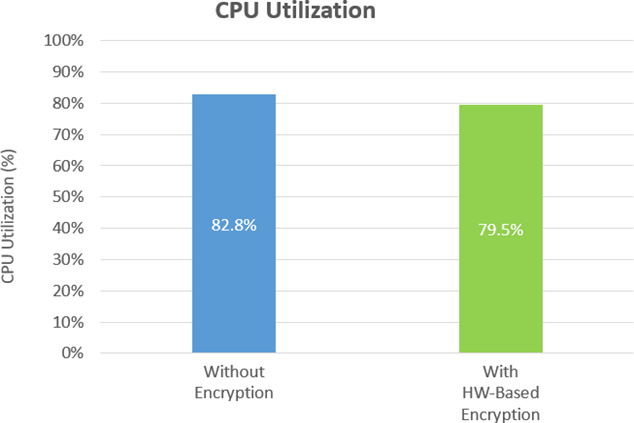
Test Analysis
The test results validated that KIOXIA CM6-R Series SSDs enabled the Dell R7525 rack server to deliver nearly identical TPM performance whether encryption was enabled or not. This particular PCIe 4.0 NVMe server/storage configuration was able to deliver more than 720,000 TPM without any TPM-related performance degradation regardless of encryption being enabled or disabled. As a result, systems and applications that use SSDs based on the TCG-OPAL standard are enabled to utilize the CPU for performance tasks instead of encryption tasks.
Whether hardware encryption was enabled or disabled, there was about 3% deviation of the CPU utilization during the testing process which demonstrated that the CPU wasn’t processing any extra workloads for encryption.
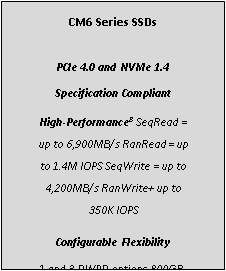
CM6 Series SSD Overview
The CM6 Series is KIOXIA’s 3rd generation enterprise-class NVMe SSD product line that features significantly improved performance from PCIe Gen3 to PCIe Gen4, 30.72TB maximum capacity, dual-port for high availability, 1 DWPD for read-intensive applications (CM6-R Series) and 3 DWPD for mixed use applications (CM6- V Series), up to a 25-watt power envelope and a host of security options – all of which are geared to support a wide variety of workload requirements. The CM6 Series SSD architecture has encryption built into the data path so as the drive is reading and writing from NAND flash memory, the encryption or decryption is performed in a way that it has no material impact to performance9.
Summary
Encryption becomes more important than ever to secure data. An ideal encrypted solution does not impact application or system performance. The test results presented validate that a PowerEdge R7525 PCIe 4.0 enabled server with KIOXIA CM6-R Series SSDs effectively delivered identical TPM performance of more than 720,000 TPM, whether encryption was enabled or not. As data usage scales over time, performance is not affected by encryption no matter how much data is being encrypted at rest. CPU utilization was also comparable with or without encryption enabled which validated that the CPU (at approximately 80% utilization) was not impacted when encryption was enabled. The Dell EMC and KIOXIA server solution delivered encryption protection without a performance hit!!!
Notes
1 Self-Encrypting Drives encrypt all data to SSDs and decrypt all data from SSDs, via an alphanumeric key (or password protection) to prevent data theft. It continuously scrambles and descrambles data written to and retrieved from SSDs.
2 The Advanced Encryption Standard (AES) is a specification for the encryption of electronic data established by the U.S. National Institute of Standards and Technology in 2001.
3 Developed by the Trusted Computing Group (TCG), a not-for-profit international standards organization, the OPAL specification is used for applying hardware-based encryption to solid state drives and often referred to as TCG-OPAL.
4 HammerDB is benchmarking and load testing software that is used to test popular databases. It simulates the stored workloads of multiple virtual users against specific databases to identify transactional scenarios and derive meaningful information about the data environment, such as performance comparisons. TPC Benchmark C is a supported OLTP benchmark that includes a mix of five concurrent transactions of different types, and nine types of tables with a wide range of record and population sizes and where results are measured in transactions per minute.
5 Definition of capacity - KIOXIA Corporation defines a megabyte (MB) as 1,000,000 bytes, a gigabyte (GB) as 1,000,000,000 bytes and a terabyte (TB) as 1,000,000,000,000 bytes. A computer operating system, however, reports storage capacity using powers of 2 for the definition of 1Gbit = 230 bits = 1,073,741,824 bits, 1GB = 230 bytes = 1,073,741,824 bytes and 1TB = 240 bytes = 1,099,511,627,776 bytes and therefore shows less storage capacity. Available storage capacity (including examples of various media files) will vary based on file size, formatting, settings, software and operating system, and/or pre-installed software applications, or media content. Actual formatted capacity may vary.
6 2.5-inch indicates the form factor of the SSD and not the drive’s physical size.
7 Drive Write(s) per Day: One full drive write per day means the drive can be written and re-written to full capacity once a day, every day, for the specified lifetime. Actual results may vary due to system configuration, usage, and other factors.
8 Read and write speed may vary depending on the host device, read and write conditions, and the file size.
9 Variances in individual test queries may occur in normal test runs. Average performance over time was consistent for encryption enabled and encryption disabled.
Trademarks
AMD, EPYC and combinations thereof are trademarks of Advanced Micro Devices, Inc. Dell, Dell EMC and PowerEdge are either registered trademarks or trademarks of Dell Inc. Microsoft, Windows and SQL Server are either registered trademarks or trademarks of Microsoft Corporation in the United States and/or other countries. NVMe is a registered trademark of NVM Express, Inc. PCIe is a registered trademark of PCI-SIG. TPC-C is a trademark of the Transaction Processing Performance Council. All company names, product names and service names may be the trademarks of their respective companies.
Disclaimers
© 2021 Dell, Inc. All rights reserved. Information in this performance brief, including product specifications, tested content, and assessments are current and believed to be accurate as of the date that the document was published, but is subject to change without prior notice. Technical and application information contained here is subject to the most recent applicable product specifications.

Protect Sensitive Data with a Confidential Computing Solution
Tue, 17 Jan 2023 06:08:27 -0000
|Read Time: 0 minutes
Summary
There are multiple considerations to take into account when deploying artificial intelligence and machine learning environments. This paper serves as a discussion and suggestion as to the possible hardware configurations to achieve a server infrastructure deployment that is secure and can grow with your increased need.
Enterprises in most industries are applying artificial intelligence/machine learning (AI/ML) to data. However, data privacy and sensitivity issues are preventing the use of AI/ML in health and financial sectors. This data cannot be shared, and it is limited to on- premises usage. Although this data must be protected from exposure to unauthorized parties, it is a valuable resource that could lead to groundbreaking discoveries and innovation in areas such as pandemic response, anti-money-laundering tactics and human trafficking
Confidential computing offers a way to expand the utility of such data while also keeping sensitive details sequestered and private. Dell EMC™ PowerEdge™ servers, built on 3rd Generation Intel® Xeon® Scalable processors, are available for the first time with confidential computing. A key feature is Intel Software Guard Extensions (Intel SGX), which provides an extra layer of hardware-based encryption in memory that helps protect data while it is being accessed. With Intel SGX, organizations can access and use multiple expansive datasets for AI applications, leading to greater insights. Intel SGX also helps ensure the integrity of the AI app to protect against intrusion, and it provides increased integrity to the platform whilst helping satisfy sovereignty requirements.
Key Considerations
- Decrease attack surfaces. Dell EMC PowerEdge servers based on Intel technologies expose fewer attack surfaces to hackers by making use of Intel SGX. The entire solution is built on an architecture that provides multiple layers of hardware- and software- based security. Security settings can be tailored to sequester only the most sensitive, privacy-protected data on Intel SGX to optimize performance.
- Accelerate inferencing. Intel performance optimizations that are built into Dell EMC PowerEdge servers can help speed AI inferencing. These optimizations include Intel and open-source software and hardware technologies, such as Intel Deep Learning Boost (Intel DL Boost) with Vector Neural Network Instructions (VNNI) for AI acceleration, Intel oneAPI Deep Neural Network Library (Intel oneDNN), the OpenVINO™ toolkit and optimized versions of TensorFlow™ and PyTorch®.
- Secure ecosystem. By creating a confidential computing environment with Intel SGX, ecosystem partners can improve the security of data collaboration between organizations that might have a need to keep data confidential and to protect intellectual property, even if a lack of trust exists between the parties. Secure ecosystem partners enable code and system integrity with Intel SGX for a growing list of AI solutions.
Available Configurations
| Base Configuration | Plus Configuration (More Memory for Larger Workloads) |
Platform | Dell EMC™ PowerEdge™ R650 servers, supporting 10 NVM Express® (NVMe®) drives (direct connection with no Dell™ PowerEdge RAID Controller [PERC]), 1 RU | |
CPU | 2 x Intel® Xeon® Gold 6348 processor (28 cores at 2.6 GHz) with 64 GB/CPU Intel® SGX enclave capacity | 2 x Intel® Xeon® Platinum 8368 processor (38 cores at 2.4 GHz) with 512 GB/CPU Intel® SGX enclave capacity |
DRAM | 256 GB (16 x 16 GB DDR4-3200) | 512 GB (16 x 32 GB DDR4-3200) |
Boot device | Dell EMC™ Boot Optimized Server Storage (BOSS)-S2 with 2 x 480 GB Intel® SSD S4510 M.2 Serial ATA (SATA) (RAID1) | |
Storage adapter | Dell PERC H755N front NVMe RAID adapteri | |
Cache storage (optional) | 1 x 400 GB Intel® Optane™ SSD P5800X (PCIe Gen4) or 1 x 375 GB Intel® Optane SSD DC P4800X (PCIe Gen3)ii | |
Capacity storage | 1 x (up to 9 x) 3.84 TB Intel® SSD P5500 (PCIe Gen4, read intensive) | |
Network interface controller (NIC) | Intel® Ethernet Network Adapter E810-XXV for OCP3 (dual-port 25 Gb) | |
Learn More
Written with Intel
Learn more about secure AI inferencing:
- “Intel and Consilient Join Forces to Fight Financial Fraud with AI”
- “Intel SGX Enables Magnit to Create a Trusted Computing Environment”
- “Spain’s largest hospitals connect for federated learning”
Contact your Dell or Intel account team. 1-877-289+-3355
- Read the Principled Technologies report: “Reap better SQL Server OLTP performance with next-generation Dell EMC PowerEdge MX servers.”
- View the Principled Technologies vSAN infographic.
i An NVM Express® (NVMe®) RAID adapter is optional, but it is recommended for configurations with a large number of capacity drives.
ii Cache storage is optional. Intel® Optane™ SSD P5800X drives are recommended when available, but the previous-generation Intel® Optane SSD DC P4800X can be used otherwise.
The information in this publication is provided as is. Dell Inc. makes no representations or warranties of any kind with respect to the information in this publication, and specifically disclaims implied warranties of merchantability or fitness for a particular purpose.

Deploy Splunk Enterprise Efficiently with Red Hat OpenShift on Dell Servers with Intel® Technologies
Tue, 17 Jan 2023 05:13:39 -0000
|Read Time: 0 minutes
Summary
Splunk Enterprise containerized deployments with Red Hat OpenShift can deliver substantial business benefits. In this brief, Intel and Dell technologists discuss key considerations to successfully deploy Splunk based containers, with recommendations on configurations based on the most recent 15th Generation PowerEdge Server portfolio offerings.
Integrating data strategy into business strategy is key to digital transformation. To harness the value of untapped data, many organizations are turning to Splunk Enterprise, a high-performance data-analytics platform that enables decision makers to bring data to every question, decision, and action.
To deploy workloads like Splunk Enterprise more efficiently, IT architects are choosing containerization. Red Hat OpenShift, an enterprise-ready Kubernetes container platform, is a popular choice. By using Red Hat OpenShift, architects don’t need to separate dedicated nodes for each Splunk Enterprise function, and they can add more nodes and scale them separately from storage.
Intel and Splunk have partnered to develop recommended hardware configurations for deploying Splunk Enterprise with Red Hat OpenShift on Dell PowerEdge servers. Organizations that use these configurations can benefit from the high performance enabled by Intel® compute, storage, and network technologies.
Key Considerations
Key considerations for deploying Splunk Enterprise with Red Hat OpenShift successfully include:
- Size local NVM Express (NVMe) storage. Size local NVMe storage for persistent volumes according to the expected ingestion rate and hot-data-retention period. Size by adding more or larger drives.
- Deploy additional storage nodes. Deploy additional storage nodes to scale object-store capacity for Splunk SmartStore independently of worker nodes. Optimize for the expected ingestion rate and warm or cold data retention using high-performance (with NVMe solid-state drives [SSDs]) or high-capacity (with rotational hard-disk drives [HDDs]) configurations with a set of storage policies. An in- cluster solution based on MinIO is recommended. Alternatively, an external S3-compatible object store like Dell PowerScale (Isilon) or Elastic Cloud Storage (ECS) can be used. For dedicated network storage, an additional network interface controller (NIC) can be used. Contact Dell Technologies for help choosing the proper storage solution.
- Manage NVMe drives. Manage NVMe drives for local and object storage using the Local Storage Operator. If necessary, partition the drives to get more volumes with smaller size. Configure proper redundancy and replication on the application layer.
Available Configurations
| Red Hat OpenShift Control Plane (Master) Nodes-3 Nodes Required | Splunk Worker Nodes | Optional Dedicated Storage Node for Object Storage | ||||
Platform | Dell PowerEdge R650 server supporting 10 x 2.5” drives with NVMe backplane | Dell PowerEdge R750 server supporting 16 x 2.5” drives with NVMe backplane (direct) | Dell PowerEdge R650 server supporting 10 x 2.5” drives with NVMe backplane (direct) | Dell PowerEdge R750 server supporting 12 x 3.5” drives with Serial- Attached SCSI (SAS)/Serial ATA (SATA) backplane | |||
Node type |
| Base configuration | Plus configuration | High performance | High capacity | ||
CPU | 2 x Intel® Xeon® Gold 6326 processor (16 cores at 2.9 GHz) or better | 2 x Intel® Xeon® Gold 6348 processor (28 cores at 2.6 GHz) | 2 x Intel® Xeon® Platinum 8360Y processor (36 cores at 2.4 GHz) | 2 x Intel® Xeon® Gold 6342 processor (24 cores at 2.8 GHz) | 2 x Intel® Xeon® Gold 6326 processor (16 cores at 2.9 GHz) | ||
DRAM | 128 GB (16 x 8 GB DDR4-3200) | 256 GB (16 x 16 GB DDR4-3200) | 512 GB (16 x 32 GB DDR4- 3200) | 128 GB (16 x 8 GB DDR4-3200) | |||
Storage controller | Not applicable (N/A) | HBA355i adapter | |||||
Persistent memory | Not applicable N/A | Optional | N/A | ||||
Boot device | Dell Boot Optimized Server Storage (BOSS)-S2 with 2 x 480 GB M.2 SATA SSD (RAID1) | ||||||
Ephemeral storagei |
1 x 1.6 TB Intel® SSD P5600 NVMe |
1 x 1.6 TB Intel® SSD P5600 (PCIe Gen4, mixed-use) |
N/A | ||||
Local storageii | N/A | 1 x (up to 5 x) 1.6 TB or 3.2 TB Intel® SSD P5600 (PCIe Gen4, mixed-use) | N/A | ||||
Object storageiii |
N/A |
4 x (up to 10 x) 2 TB, 4 TB or 8 TB Intel® SSD P5500 (PCIe Gen4, read-intensive) |
Up to 10 x 2 TB, 4 TB, 8 TB Intel® SSD P5500 (PCIe Gen4, read-intensive) |
Up to 12 x 8 TB, 12 TB, 18 TB 3.5-in 12 Gbps SAS HDD 7.2K rotations per minute (RPM) | |||
Network interface controller (NIC)iv | Intel® Ethernet Network Adapter E810-XXVDA2 for OCP3 (dual-port 25 gigabit Ethernet [GbE]) | Intel® Ethernet Network Adapter E810-XXV for OCP3 (dual-port 25 Gb) or Intel Ethernet Network Adapter E810-CQDA2 PCIe add-on card (dual-port 100 Gb) | Intel® Ethernet Network Adapter E810-CQDA2 PCIe add-on card (dual- port 100 Gb) | Intel® Ethernet Network Adapter E810-XXV for OCP3 (dual-port 25 Gb) | |||
Additional NIC for external storagev |
N/A | Intel® Ethernet Network Adapter E810-XXV PCIe add-on card (dual- port 25 Gb) or Intel® Ethernet Network Adapter E810-CQDA2 PCIe add-on card (dual-port 100 Gb) |
N/A | ||||
Learn More
Contact your dedicated Dell or Intel account team for a customized quote. 1-877-289-3355 “Build High Performance Splunk SmartStores with MinIO”
“Harness the Power of Splunk with Dell Storage”
i Ephemeral storage is used only for container images and ephemeral volumes.
ii Local storage for persistent volumes includes Splunk® hot tier.
iii The number of drives and capacity for MinIO® object storage depends on the dataset size and performance requirements.
iv 100 Gb NICs recommended for higher throughput.
v Optional; required only if dedicated storage network for external storage system is necessary.
Note: This document may contain language from third-party content that is not under
Dell Technologies’ control and is not consistent with current guidelines for Dell Technologies’ own content. When such third-party content is updated by the relevant third parties, this document will be revised accordingly.

Access Data Insights Faster by Deploying Splunk Enterprise with VMware Tanzu
Tue, 17 Jan 2023 05:06:20 -0000
|Read Time: 0 minutes
Summary
Splunk Enterprise containerized deployments with VMWare Tanzu can deliver substantial business benefits. In this brief, Intel and Dell technologists discuss key considerations to successfully deploy Splunk based containers, with recommendations on configurations based on the most recent 15th Generation PowerEdge Server portfolio offerings.
Enterprises have massive amounts of data available, but in raw form: there is still a lot of work to do. Data comes from different sources, in different structures, and on different time scales. To pull data together for analysis and gain insights for business transformation, enterprises turn to Splunk Enterprise, a data-analytics platform that enables enterprises to monitor, analyze, and act on data. The resulting insights enable decision makers to identify security threats, optimize application performance, understand customer behavior, and more.
To deploy Splunk Enterprise more efficiently, organizations are using Kubernetes container orchestration through tools like VMware Tanzu. Containers are lightweight, efficient ways to deploy and manage applications.
This article outlines recommended hardware configurations for deploying Splunk Enterprise with VMware Tanzu on Dell PowerEdge servers. These configurations feature Intel® Xeon® Scalable processors, Intel® Optane™ storage and Intel® Ethernet Network Adapters to enable high performance.
Key Considerations
Key considerations for deploying Splunk using VMware Tanzu include the following. Note that VMware Tanzu is deployed on VMware vSphere with VMware vSAN underneath.
- Size persistent volumes based on ingestion rate. Persistent volumes are stored on the vSAN storage and should be sized according to the expected ingestion rate and hot data retention period. More and/or larger drives for vSAN can be used if necessary.
- Use high-performance or high-capacity configurations for object storage. Object storage capacity can be scaled independently of worker nodes by deploying additional storage nodes. Both high- performance (with NVM Express [NVMe] solid-state drives [SSDs]) and high-capacity (with rotational hard-disk drives [HDDs]) configurations can be used. An in-cluster solution based on MinIO is recommended. Alternatively, an external S3-compatible object store like Dell PowerScale (Isilon) or Elastic Cloud Storage (ECS) is an option. An additional network interface controller (NIC) can be used for dedicated network storage. Contact Dell Technologies for help choosing the proper storage solution.
- Deploy VMware vCenter management virtual machines (VMs). Deploy VMware vCenter management VMs on the same cluster. Deployment outside the cluster on a separate machine is not covered in this hardware bill of materials (BoM).
Available Configurations
Node Type | Splunk Worker Nodes (Minimum of 4 Nodes Required, up to 64 Nodes per Cluster) | Optional Dedicated Storage Nodes | |||
High Performance | High Capacity | ||||
Platform | Dell PowerEdge R750 server supporting 16 x 2.5” drives with NVMe backplane— direct connection | Dell PowerEdge R650 server supporting 10 x 2.5” drives with NVMe backplane | Dell PowerEdge R750 supporting 12 x 3.5” drives with Serial- Attached SCSI (SAS)/Serial ATA (SATA) backplane | ||
CPU | Base Configuration | Plus Configuration | 2 x Intel® Xeon® Gold 6342 processor (24 cores at 2.8 GHz) | 2 x Intel® Xeon® Gold 6326 processor (16 cores at 2.9 GHz) | |
2 x Intel® Xeon® Gold 6348 processor (28 cores at 2.6 GHz) | 2 x Intel® Xeon® Platinum 8360Y processor (36 cores at 2.4 GHz) | ||||
DRAM | 256 GB (16 x 16 GB DDR4-3200) | 512 GB (16 x 32 GB DDR4-3200) | 128 GB (16 x 8 GB DDR4-3200) | ||
Storage controller | Not applicable (N/A) | HBA355i adapter | |||
Persistent memory | Optional | N/A | |||
Boot device | Dell Boot Optimized Server Storage (BOSS)-S2 with 2 x 480 GB M.2 SATA SSD (RAID1) | ||||
VMware vSAN cache tieri | 2 x 400 GB Intel® Optane™ SSD P5800X (PCIe Gen4) |
N/A | |||
VMware vSAN capacity tierii | 4 x 1.92 TB or 3.84 TB Intel® SSD P5500 (PCIe Gen4, read-intensive) | N/A | |||
Object storageiii | 4 x (up to 10 x) 1.92 TB, 3.84 TB or 7.68 TB Intel® SSD P5500 (PCIe Gen4, read- intensive) | Up to 10 x 1.92 TB, 3.84 TB or 7.68 TB Intel® SSD P5500 (PCIe Gen4, read-intensive) | Up to 12 x 8 TB, 12 TB or 18 TB 3.5-in 12 Gbps SAS HDD, 7.2K rotations per minute (RPM) | ||
NICiv |
Intel® Ethernet Network Adapter E810- XXV for OCP3 (dual-port 25 Gb) or Intel® Ethernet Network Adapter E810-CQDA2 PCIe add-on card (dual-port 100 Gb) | Intel® Ethernet Network Adapter E810-CQDA2 PCIe add-on card (dual-port 100 Gb) | Intel® Ethernet Network Adapter E810-XXV for OCP3 (dual-port 25 Gb) | ||
Additional NICv | Intel® Ethernet Network Adapter E810- XXV for OCP3 (dual-port 25 Gb) or Intel® Ethernet Network Adapter E810-CQDA2 PCIe add-on card (dual-port 100 Gb) |
N/A | |||
Learn More
Written With Intel
Contact your dedicated Dell or Intel account team for a customized quote. 1-877-289-3355 “Build High Performance Splunk SmartStores with MinIO”
“Harness the Power of Splunk with Dell Storage”
i VMware vSAN storage used for VMs and container ephemeral and persistent volumes.
ii VMware vSAN storage used for VMs and container ephemeral and persistent volumes.
iii Number of drives and capacity for MinIO object storage depends on the dataset size and performance requirements.
iv 100 Gb NICs recommended for higher throughput.
v Optional; required only if a dedicated storage network for external storage system is necessary.

Dell Next Generation PowerEdge Servers: Designed for PCIe Gen4 to Deliver Future Ready Bandwidth
Tue, 17 Jan 2023 00:18:59 -0000
|Read Time: 0 minutes
Summary
PCIe is the primary interface for connecting various peripherals in a server. The Next Generation of Dell PowerEdge servers have been designed keeping PCIe Gen4 in mind. PCIe Gen4 effectively doubles the throughput available per lane compared to PCIe Gen3.
The PCIe Interface
PCIe (Peripheral Component Interconnect Express) is a high- speed bus standard interface for connecting various peripherals to the CPU. This standard is maintained and developed by the PCI- SIG (PCI-Special Interest Group), a group of more than 900 companies. In today’s world of servers, PCIe is primary interface for connecting peripherals. It has numerous advantages over the earlier standards, being faster, more robust and very flexible. These advantages have cemented the importance of PCIe.
PCIe Gen 3 was the third major iteration of this standard. Dell PowerEdge 14G systems were designed keeping PCIe Gen 3 in min PCIe Gen3 can carry a bit rate of 8 Gigatransfers per second (GT/s). After considering the overhead of the encoding scheme, this works out to an effective delivery of 985 MB/s per lane, in each direction. A PCIe Gen3 slot with 8 lanes (x8) can have a total bandwidth of 7.8 GB/s.
PCIe Gen 4 is the fourth major iteration of the PCIe standard. This generation doubles the throughput per lane to 16 GT/s. This works out to an effective throughput of 1.97 GB/s per lane in each direction, and 15.75GB/s for a x8 PCIe Gen4 slot.
Designing for PCIe Gen4
The Next Generation of Dell PowerEdge servers were designed with a new PSU Layout. One of the key reasons this was done was to simplify enabling PCIe Gen4. A key element in PCIe performance is the length of PCIe traces. With the new system layout, a main goal was to shorten the overall PCIe trace lengths in the topology, including traces in the motherboard. By positioning PSU’s at both edges, the I/O traces to connectors can be shortened for both processors. This is the optimal physical layout for PCIe Gen 4 and will enable even faster speeds for future platforms. The shorter PCIe traces translate into better system costs and improved Signal Integrity for more reliable performance across a broad variety of customer applications. Another advantage of the split PSU is the balanced airflow that results. The split PSU layout helps to balance the system airflow, reduce PSU operating temperatures, and allows for PCIe Gen4 card support and thus an overall more optimal system design layout.
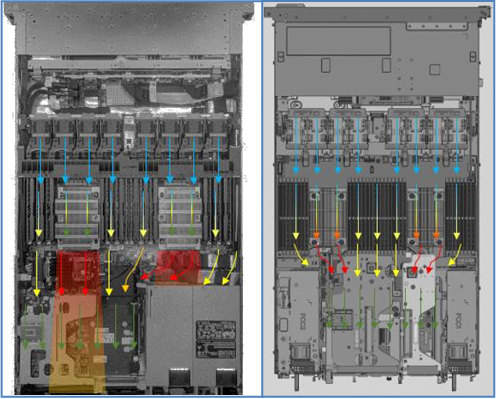
Figure 1 - Figures showing the 14G server layout to the left and the balanced airflow of the next gen Dell PowerEdge platforms to the right.
2nd and 3rd Gen AMD EPYC™ Processors
Next Generation Dell PowerEdge servers with AMD processors are designed for PCIe Gen4. The 2nd and 3rd Generation AMD EPYC processors support the PCIe Gen4 standard allowing for the maximum utilization of this available bandwidth. A single socket 2nd or 3rd Gen AMD EPYC processors have 128 available PCIe Gen4 lanes for use. This allows for great flexibility in design. 128 lanes also give plenty of bandwidth for many peripherals to take advantage of the high core count CPUs.
The dual socket platform offers an additional level of flexibility to system designers. In the standard configuration, 128 PCIe Gen4 lanes are available for peripherals. The rest of the lanes are used for inter-socket communication. Some of these inter-socket xGMI2 lanes can be repurposed to add an additional 32 lanes. This gives a total of 160 PCIe Gen4 lanes for peripherals (Figure 2). This flexibility allows for a wide variety of configurations and maximum CPU-peripheral bandwidth.
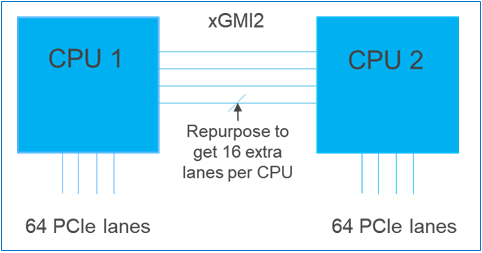
Figure 2 - Diagram showing PCIe lanes in a 2-socket configuration
3rd Gen Intel® Xeon® Scalable Processors
Intel highlighted that the next generation of processors will deliver performance-optimized features for a range of key workloads. Increased memory bandwidth, a new high-performance Sunny Cove core architecture, increased processor core count and support for PCIe Gen4 will enhance performance across different disciplines, including life sciences, material science and weather modeling. These processors will be available throughout the Intel products found within the PowerEdge portfolio of servers.
Conclusion
PowerEdge servers continue to deliver best-in-class features. The new PowerEdge servers have support for the higher speed PCIe Gen4, with innovative designs to improve signal integrity and chassis airflow.

Using NVMe Namespaces to Increase Performance in a Dell PowerEdge R7525 Server
Mon, 16 Jan 2023 23:10:15 -0000
|Read Time: 0 minutes
Summary
This document summarizes how NVMe namespaces can be used to increase performance in Dell PowerEdge R7525 servers using KIOXIA CM6 Series NVMe enterprise SSDs.
All performance and characteristics discussed are based on performance testing conducted in KIOXIA America, Inc. application labs.
Results are accurate as of September 1, 2022
Introduction
A key goal of IT administrators is to deliver fast storage device performance to end- users in support of the many applications and workloads they require. With this objective, many data center infrastructures have either transitioned to, or are transitioning to, NVMe storage devices, given the very fast read and write capabilities they possess. Selecting the right NVMe SSD for a specific application workload or for many application workloads is not always a simple process because user requirements can vary depending on the virtual machines (VMs) and containers for which they are deployed. User needs can also dynamically change due to workload complexities and other aspects of evolving application requirements. Given these volatilities, it can be very expensive to replace NVMe SSDs to meet the varied application workload requirements.
To achieve even higher write performance from already speedy PCIe® 4.0 enterprise SSDs, using NVMe namespaces is a viable solution. Using namespaces can also deliver additional benefits such as better utilization of a drive’s unused capacity and increased performance of random write workloads. The mantra, ‘don’t let stranded, unused capacity go to waste when random performance can be maximized,’ is a focus of this performance brief.
Random write SSD performance effect on I/O blender workloads
The term ‘I/O blender’ refers to a mix of different workloads originating from a single application or multiple applications on a physical server within bare-metal systems or virtualized / containerized environments. VMs and containers are typically the originators of I/O blender workloads.
When an abundance of applications run simultaneously in VMs or containers, both sequential and random data input/output (I/O) streams are sent to SSDs. Any sequential I/O that exists at that point is typically mixed in with all of the other I/O streams and essentially becomes random read/write workloads. As multiple servers and applications process these workloads and move data at the same time, the SSD activity changes from just sequential or random read/write workloads into a large mix of random read/write I/Os - the I/O blender effect.
As almost all workloads become random mixed, an increase in random write performance can have a large impact on the I/O blender effect in virtualized and containerized environments.
The I/O blender effect can come into play at any time where multiple VMs and/or containers run on a system. Even if a server is deployed for a single application, the I/O written to the drive can still be highly mixed with respect to I/O size and randomness. Today’s workload paradigm is to use servers for multiple applications, not just for a single application. This is why most modern servers are deployed for virtualized or containerized environments. It is in these modern infrastructures where the mix of virtualized and containerized workloads creates the I/O blender effect, and is therefore applicable to almost every server that ships today. Supporting details include a description of the test criteria, the set-up and associated test procedures, a visual representation of the test results, and a test analysis.
Addressing the I/O blender effect
Under mixed workloads, some I/O processes that typically would have been sequential in isolation become random. This can increase SSD read/write activity, as well as latency (or the ability to access stored data). One method used to address the I/O blender effect involves allocating more SSD capacity for overprovisioning (OP).
Overprovisioning
Overprovisioning means that an SSD has more flash memory than its specified user capacity, also known as the OP pool. The SSD controller uses the additional capacity to perform various background functions (transparent to the host) such as flash translation layer (FTL) management, wear leveling, and garbage collection (GC). GC, in particular, reclaims unused storage space which is very important for large write operations.
The OP pool is also very important for random write operations. The more random the data patterns are, the more it allows the extra OP to provide space for the controller to place new data for proper wear leveling and reduce write amplification (while handling data deletions and clean up in the background). In a data center, SSDs are rarely used for only one workload pattern. Even if the server is dedicated to a single application, other types of data can be written to a drive, such as logs or peripheral data that may be contrary to the server’s application workload. As a result, almost all SSDs perform random workloads. The more write-intensive the workload is, the more OP is needed on the SSD to maintain maximum performance and efficiency
Namespaces
Namespaces divide an NVMe SSD into logically separate and individually addressable storage spaces where each namespace has its own I/O queue. Namespaces appear as a separate SSD to the connected host that interacts with them as it would with local or shared NVMe targets. They function similarly to a partition, but at the hardware level as a separate device. Namespaces are developed at the controller level and have the included benefit of dedicated I/O queues that may provide improved Quality of Service (QoS) at a more granular level.
With the latest firmware release of KIOXIA CM6 Series PCIe 4.0 enterprise NVMe SSDs, flash memory that is not provisioned for a namespace is added back into the OP pool, which in turn, enables higher write performance for mixed workloads. To validate this methodology, testing was performed using a CM6 Series 3.84 terabyte1 (TB), 1 Drive Write Per Day2 (DWPD) SSD, provisioned with smaller namespaces (equivalent to a CM6 Series 3.2TB 3DWPD model). As large OP pools impact performance, CM6 Series SSDs can be set to a specific performance or capacity metric desired by the end user. By using namespaces and reducing capacity, a 1DWPD CM6 Series SSD can perform comparably in write performance to a 3DWPD CM6 Series SSD, as demonstrated by the test results.
1 Definition of capacity - KIOXIA Corporation defines a kilobyte (KB) as 1,000 bytes, a megabyte (MB) as 1,000,000 bytes, a gigabyte (GB) as 1,000,000,000 bytes and a terabyte (TB) as 1,000,000,000,000 bytes. A computer operating system, however, reports storage capacity using powers of 2 for the definition of 1Gbit = 230 bits = 1,073,741,824 bits, 1GB = 230 bytes = 1,073,741,824 bytes and 1TB = 240 bytes = 1,099,511,627,776 bytes and therefore shows less storage capacity. Available storage capacity (including examples of various media files) will vary based on file size, formatting, settings, software and operating system, and/or pre-installed software applications, or media content. Actual formatted capacity may vary.
2 Drive Write(s) per Day: One full drive write per day means the drive can be written and re-written to full capacity once a day, every day, for the specified lifetime. Actual results may vary due to system configuration, usage, and other factors.
Testing Methodology
To validate the performance comparison, benchmark tests were conducted by KIOXIA in a lab environment that compared the performance of three CM6 Series SSD configurations in a PowerEdge server with namespace sizes across the classic four-corner performance tests and three random mixed-use tests. This included a CM6 Series SSD with
3.84TB capacity, 1DWPD and 3.84TB namespace size, a CM6 Series SSD with 3.84TB capacity, 1DWPD and a namespace adjustment to a smaller 3.20TB size, and a CM6 Series SSD with 3.20TB capacity, 3DWPD and 3.20TB namespace size to which to compare the smaller namespace adjustment.
The seven performance tests were run through Flexible I/O (FIO) software3 which is a tool that provides a broad spectrum of workload tests with results that deliver the actual raw performance of the drive itself. This included 100% sequential read/write throughput tests, 100% random read/write IOPS tests, and three mixed random IOPS tests (70%/30%, 50%/50% and 30%/70% read/write ratios). These ratios were selected as follows:
- 70%R / 30%W: represents a typical VM workload
- 50%R / 50%W: represents a common database workload
- 30%R / 70%W: represents a write-intensive workload (common with log servers)
In addition to these seven tests, 100% random write IOPS tests were performed on varying namespace capacity sizes to illustrate the random write performance gain that extra capacity in the OP pool provides. The additional namespace capacities tested included a CM6 Series SSD with 3.84TB capacity, 1DWPD and two namespace adjustments (2.56TB and 3.52TB).
A description of the test criteria, set-up, execution procedures, results and analysis are presented. The test results represent the probable outcomes that three different namespace sizes and associated capacity reductions have on four- corner performance and read/write mixes (70%/30%, 50%/50% and 30%/70%). There are additional 100% random write test results of four different namespace sizes when running raw FIO workloads with a CM6 Series 3.84TB, 1DWPD SSD and equipment as outlined below.
Test Criteria:
The hardware and software equipment used for the seven performance tests included:
- Dell PowerEdge R7525 Server: One (1) dual socket server with two (2) AMD EPYC 7552 processors, featuring 48 processing cores, 2.2 GHz frequency, and 256 gigabytes1 (GB) of DDR4
- Operating System: CentOS v8.4.2105 (Kernel 4.18.0-305.12.1.el8_4.x86_64)
- Application: FIO v3.19
- Test Software: Synthetic tests run through FIO v3.19 test software
- Storage Devices (Table 1):
- One (1) KIOXIA CM6 Series PCIe 4.0 enterprise NVMe SSD with 3.84 TB capacity (1DWPD)
- One (1) KIOXIA CM6 Series PCIe 4.0 enterprise NVMe SSD with 3.2 TB capacity (3DWPD)
3 Flexible I/O (FIO) is a free and open source disk I/O tool used both for benchmark and stress/hardware verification. The software displays a variety of I/O performance results, including complete I/O latencies and percentiles.
Set-up & Test Procedures
Set-up: The test system was configured using the hardware and software equipment outlined above. The server was configured with a CentOS v8.4 operating system and FIO v3.19 test software.
Tests Conducted
Test | Measurement | Block Size |
100% Sequential Read | Throughput | 128 kilobytes1 (KB) |
100% Sequential Write | Throughput | 128KB |
100% Random Read | IOPS | 4KB |
100% Random Write | IOPS | 4KB |
70%R/30%W Random | IOPS | 4KB |
50%R/50%W Random | IOPS | 4KB |
30%R/70%W Random | IOPS | 4KB |
Test Configurations
Product | Focus | SSD Type | Capacity Size | Namespace Size |
CM6 Series | Read-intensive | Sanitize Instant Erase4 (SIE) | 3.84TB | 3.84TB |
CM6 Series | Read-intensive | SIE | 3.84TB | 3.52TB |
CM6 Series | Read-intensive | SIE | 3.84TB | 3.20TB |
CM6 Series | Read-intensive | SIE | 3.84TB | 2.56TB |
CM6 Series | Mixed-use | SIE | 3.20TB | 3.20TB |
Note: The SIE drives used for testing have no performance differences versus CM6 Series Self-Encrypting Drives5 (SEDs) or those without encryption, and their selection was based on test equipment availability at the time of testing.
Utilizing FIO software, the first set of seven tests were run on a CM6 Series SSD with 3.84TB capacity, 1DWPD and
3.84TB namespace size. The results were recorded.
The second set of seven FIO tests were then run on the same CM6 Series SSD, except that the namespace size was changed to 3.2TB to represent the namespace size of the third SSD to be tested against - the 3DWPD CM6 Series SSD with 3.2TB capacity, 3DWPD and 3.2TB namespace size. The results for these tests were recorded.
The third set of seven FIO tests were then run on the CM6 Series SSD with 3.2TB capacity, 3DWPD and 3.2TB namespace size, and the performance that the CM6 Series SSD (3.84TB capacity, 1DWPD, 3.84TB namespace size) is trying to achieve. The results for these tests were recorded.
4 Sanitize Instant Erase (SIE) drives are compatible with the Sanitize device feature set, which is the standard prescribed by NVM Express, Inc. It was first introduced in the NVMe v1.3 specification and improved in the NVMe v1.4 specification, and by the T10 (SAS) and T13 (SATA) committees of the American National Standards Institute (ANSI).
5 Self-Encrypting Drives (SEDs) encrypt/decrypt data written to and retrieved from them via a password-protected alphanumeric key (continuously encrypting and decrypting data).
Additionally, a 100% random write FIO test was run on the CM6 Series SSD, except that the namespace size was changed to 2.56TB. The results for this test were recorded. A second 100% random write FIO test was run on the CM6 Series SSD with the namespace size changed to 3.52TB. The results for this test were also recorded.
The steps and commands used to change the respective namespace sizes include:
Step 1: Delete the namespace that currently resides on the SSD:
(1) sudo nvme detach-ns /dev/nvme1 –n 1 ; (2) sudo nvme delete-ns /dev/nvme1 –n 1
Step 2: Create a 3.84 TB namespace and attach it sudo nvme create-ns /dev/nvme1
-s 7501476528
-c 7501476528 -b 512
sudo nvme attach-ns /dev/nvme1 -n1 -c1 | Create a 3.52 TB namespace and attach it* sudo nvme create-ns /dev/nvme1
-s 6875000000
-c 6875000000 -b 512
sudo nvme attach-ns /dev/nvme1 -n1 -c1 | Create a 3.2 TB namespace and attach it* sudo nvme create-ns /dev/nvme1
-s 6251233968
-c 6251233968 -b 512
sudo nvme attach-ns /dev/nvme1 -n1 -c1 | Create a 2.56 TB namespace and attach it* sudo nvme create-ns /dev/nvme1
-s 5000000000
-c 5000000000 -b 512
sudo nvme attach-ns /dev/nvme1 -n1 -c1 |
*The additional namespaces were tested by repeating Steps 1 and 2, but replacing the namespace parameter value so that the sectors match the desired namespace capacity6.
Test Results
The objective of these seven FIO tests was to demonstrate that a 1DWPD CM6 Series SSD can perform comparably in write performance to a 3DWPD CM6 Series SSD by using NVMe namespaces and reducing capacity. The throughput (in megabytes per second or MB/s) and random performance (in input/output operations per second or IOPS) were recorded.
Sequential Read/Write Operations: Read and write data of a specific size that is ordered one after the other from a Logical Block Address (LBA).
Random Read/Write/Mixed Operations: Read and write data of a specific size that is ordered randomly from an LBA.
Snapshot of Results:
Performance Test | 1st Test Run: 3.84TB Capacity 3.84TB Namespace Size | 2nd Test Run: 3.84TB Capacity 3.20TB Namespace Size | 3rd Test Run: 3.20TB Capacity 3.20TB Namespace Size |
100% Sequential Read Sustained, 128KB, QD16 | 6,971 MB/s | 6,952 MB/s | 6,972 MB/s |
100% Sequential Write Sustained, 128KB, QD16 | 4,246 MB/s | 4,246 MB/s | 4,245 MB/s |
100% Random Read Sustained, 4KB, QD32 | 1,549,202 IOPS | 1,548,940 IOPS | 1,549,470 IOPS |
6 To determine the number of sectors required for any size namespace, divide the required namespace size by the logical sector size. Using 2.56 TB as an example, 2.56 TB = 2.56 x 10^12B. Because many SSDs typically have a 512B logical sector size, divide (2.56 x 10^12B) by 512B, which equals 5,000,000,000 sectors.
100% Random Write Sustained, 4KB, QD32 | 173,067 IOPS | 337,920 IOPS | 354,666 IOPS |
70%/30% Random Mixed Sustained, 4KB, QD32 | 386,789 IOPS (R) +165,783 IOPS (W) 552,572 IOPS | 555,810 IOPS (R) +238,225 IOPS (W) 794,035 IOPS | 561,352 IOPS (R) +240,528 IOPS (W) 801,880 IOPS |
50%/50% Random Mixed Sustained, 4KB, QD32 | 170,515 IOPS (R) +170,448 IOPS (W) 340,963 IOPS | 321,712 IOPS (R) +321,757 IOPS (W) 643,469 IOPS | 325,993 IOPS (R) +325,987 IOPS (W) 651,980 IOPS |
30%/70% Random Mixed Sustained, 4KB, QD32 | 73,596 IOPS (R) +171,719 IOPS (W) 245,315 IOPS | 142,434 IOPS (R) +332,412 IOPS (W) 474,846 IOPS | 149,938 IOPS (R) +349,826 IOPS (W) 499,764 IOPS |
Tests 1 & 2: 100% Sequential Read / Write

Tests 3 & 4: 100% Random Read / Write

Test 5: Mixed Random - 70% Read / 30% Write
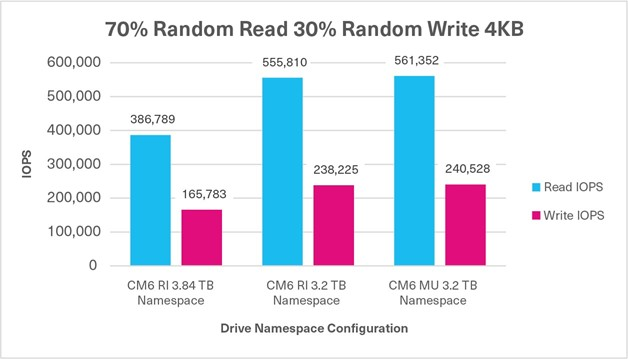
Test 6: Mixed Random - 50% Read / 50% Write
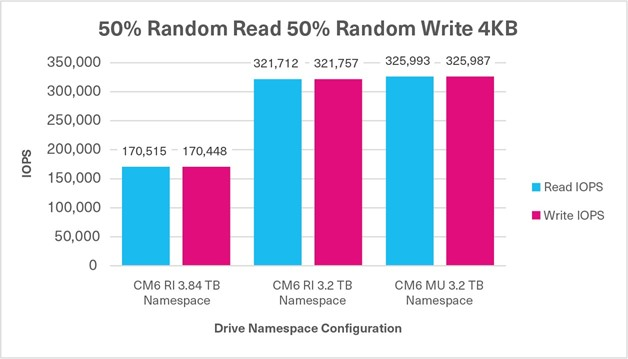
Test 7: Mixed Random - 30% Read / 70% Write

Additional Test: 100% Random Write Using 4 Namespace Sizes
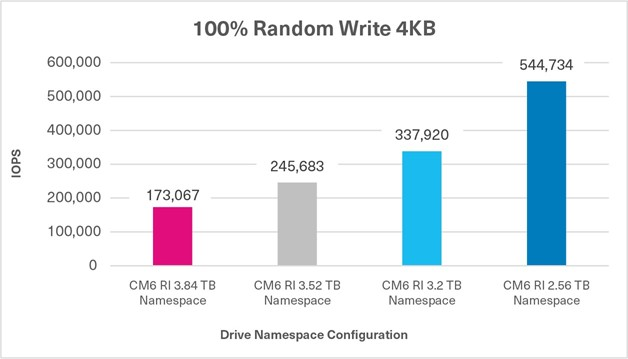
The objective of these 100% random write FIO tests was to demonstrate the increase in random write performance when using NVMe namespaces of different sizes, and reducing capacity. The random performance was recorded in IOPS.
Test Analysis
When a read or write operation is either 100% sequential or random, the performance differences between the three CM6 Series configurations were negligible based on the four FIO tests. However, when the three mixed FIO workloads were tested, the CM6 Series enabled the flash memory that was not provisioned for a namespace to be added back into the OP pool, and demonstrated higher write performance. Therefore, when provisioned with smaller namespaces, in conjunction with reducing the capacity requirements, the 3.84TB capacity, 1DWPD drive performed comparably to a 3.2TB capacity, 3DWPD drive as demonstrated by the test results. Though the 3.84TB capacity / 3.84TB CM6 Series SSD did not perform exactly to the CM6 Series 3.2TB capacity / 3.2TB namespace size SSD, the performance results were very close.
Also evident is a significant increase in the random write performance based on the allocated capacity given to a namespace, with the remaining unallocated capacity going into the OP pool courtesy of KIOXIA firmware. This enables users to have finer control over the capacity allocation for each application in conjunction with the write performance required from that presented storage namespace to the application.
ASSESSMENT: If a user requires higher write performance from their CM6 Series PCIe 4.0 enterprise NVMe SSD, using NVMe namespaces can achieve this objective.
Summary
Namespaces can be used to manage NVMe SSDs by setting the random write performance level to the desired requirement, as long as IT administration (or the user) is willing to give up some capacity. With the reality that today’s workloads are very mixed, the ability to adjust the random performance means that these mixed and I/O blender effect workloads can get maximum performance simply by giving up already unused capacity. Don’t let stranded, unused capacity go to waste when the random performance workload can be maximized!
If longer drive life is the desired objective, then using smaller namespaces to increase the OP pool is a very effective method to manage drives. Enabling these drives to be available for other applications and workloads maximizes the use of the resource as well as its life. However, the use of smaller namespaces to increase drive performance of 100% random write operations and mixed random workloads will show substantial benefit.
Additional CM6 Series SSD information is available here.
Trademarks
AMD EPYC is a trademark of Advanced Micro Devices, Inc. CentOS is a trademark of Red Hat, Inc. in the United States and other countries. Dell, Dell and PowerEdge are either registered trademarks or trademarks of Dell Inc. NVMe is a registered trademark of NVM Express, Inc. PCIe is a registered trademark of PCI-SIG. All other company names, product names and service names may be trademarks or registered trademarks of their respective companies.
Disclaimers
Information in this performance brief, including product specifications, tested content, and assessments are current and believed to be accurate as of the date that the document was published, but is subject to change without prior notice.
Technical and application information contained here is subject to the most recent applicable product specifications.

Reference Architecture: Acceleration over PCIe for Dell EMC PowerEdge MX7000
Mon, 16 Jan 2023 22:12:40 -0000
|Read Time: 0 minutes
Summary
Many of today’s most demanding applications can make use of PCIe acceleration. Liqid designed on Dell Technologies, enables the rapid and dynamic provisioning of PCIe resources such as GPU, FPGA, or NVMe to Dell EMC PowerEdge MX7000 compute sleds. Ensuring workload performance needs are met for the most accelerator hungry applications. Request a demo or quote from a Dell Technologies Design Solutions Expert Design Solution Portal.
Background
The Dell EMC PowerEdge MX7000 Modular Chassis simplifies the deployment and management of today’s most challenging workloads by allowing IT administrators to dynamically assign, move and scale shared pools of compute, storage and networking resources. It provides IT administrators the ability to deliver fast results, eliminating managing and reconfiguring infrastructure to meet ever-changing needs of their end users. The addition of PCIe infrastructure to this managed pool of resources using Liqid technology designed on Dell EMC MX7000 expands the promise of software-defined composability for today’s AI- driven compute environments and high-value applications.
GPU Acceleration for PowerEdge MX7000
For workloads like AI that require parallel accelerated computing, the addition of GPU acceleration within the PowerEdge MX7000 is paramount. With Liqid technology and management software, GPUs of any form factor can be quickly added to any new or existing MX compute sled via the management interface, quickly delivering the resources needed to manage each step of the machine learning workflow including data ingest, cleansing, training, and inferencing. Spin-up new bare-metal servers with the exact number of accelerators required and then dynamically add or remove them as workload needs change.
Essential PowerEdge Expansion Components
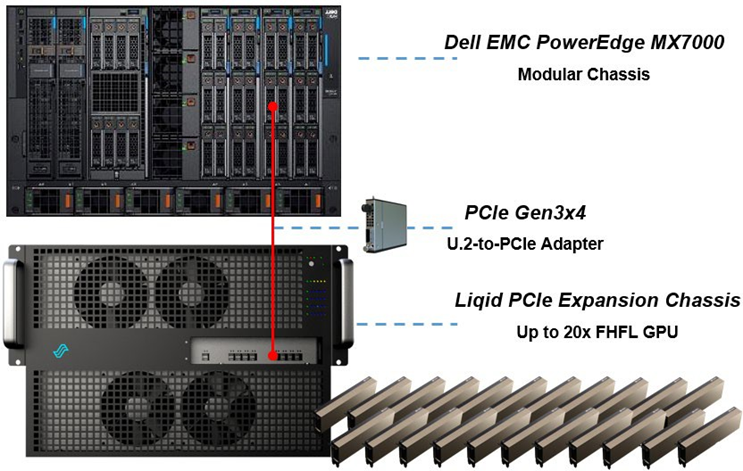
GPU Expansion Over PCIe | |
Compute Sleds | Up to 8 x Compute Sleds per Chassis |
GPU Chassis | PCIe Expansion Chassis (Contain GPU or other devices Direct Connect to Compute Sled) |
Interconnect | PCIe Gen3 x4 Per Compute Sled (Multiple Gen 3 x4 Links Possible) |
GPU Expansion | 20x GPU (FHFL) |
GPU Supported |
V100, A100, RTX, T4, Others |
OS Supported | Linux, Windows, VMWare and Others |
Devices Supported | GPU, FPGA, and NVMe Storage |
Form Factor | 14U Total = MX7000 (7U) + PCIe Expansion Chassis (7U) |
Implementing GPU Expansion for MX
GPUs are installed into the PCIe expansion chassis. Next, U.2 to PCIe Gen3 adapters are added to each compute sled that requires GPU acceleration, and then they are connected to the expansion chassis (Figure 1). Liqid Command Center software enables discovery of all GPUs, making them ready to be added to the server over native PCIe. FPGA and NVMe storage can also be added to compute nodes in tandem. This PCIe expansion chassis & software are available from the Dell Design Solutions team.

Figure 2
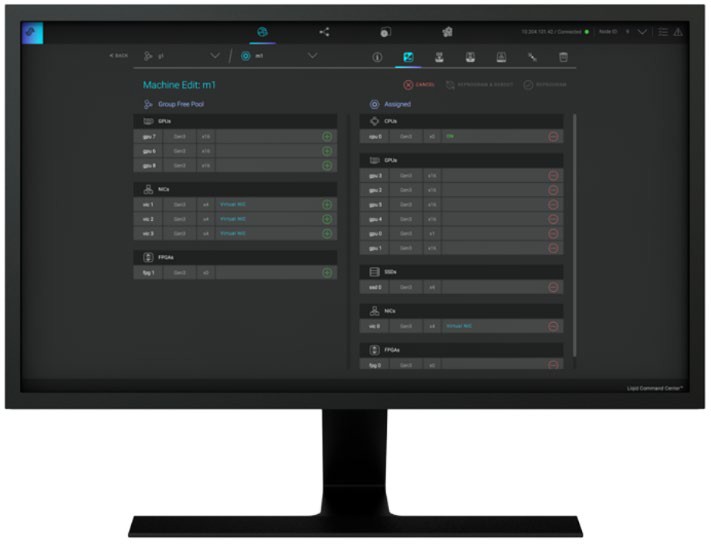
Figure 3 Liqid Command Center
Software Defined Composability
Once PCIe devices are connected to the MX7000, Liqid Command Center software enables the dynamic allocation of GPUs to MX compute sleds at the bare metal (GPU hot- plug supported). Any amount of resources can be added to the compute sleds, via Liqid Command Center (GUI) or RESTful API, in any ratio to meet the end user workload requirement To the operating system, the GPUs are
presented as local resources direct connected to the MX compute sled over PCIe (Figure 3). All operating systems are supported including Linux, Windows, and VMware. As workload needs change, add or remove resources on the fly, via software including NVMe SSD and FPGA (Table 1).
Enabling GPU Peer-2-Peer Capability
A key feature included with the PCIe expansion solution for PowerEdge MX7000 is the ability for RDMA Peer-2-Peer between GPU devices. Direct RDMA transfers have a massive impact on both throughput and latency for the highest performing GPU-centric applications. Up to 10x improvement in performance has been achieved with RDMA Peer-2-Peer enabled. Below is the overview of how PCIe Peer-2-Peer functions (Figure 4).
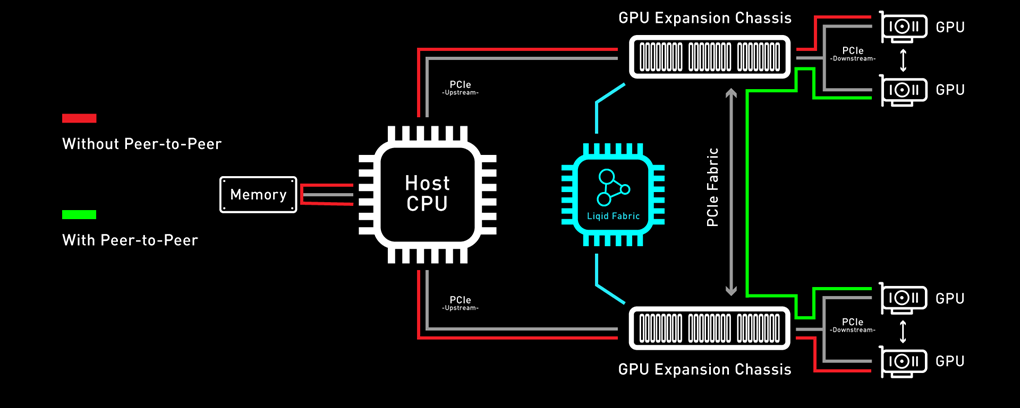
Figure 4 PCIe Peer-2-Peer
Bypassing the x86 processor and enabling direct RDMA communication between GPUs, realizes a dramatic improvement in bandwidth and in addition a reduction in latency is also realized. This chart outlines the performance expected for GPUs that are composed to a single node with GPU RDMA Peer-2-Peer enabled (Table 2).
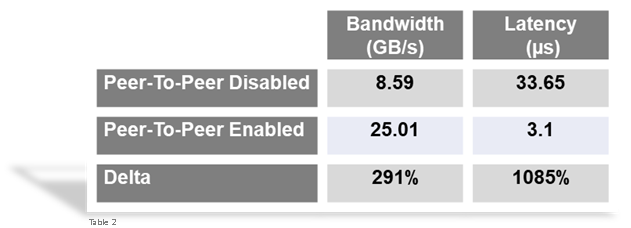
Application Level Performance
RDMA Peer-2-Peer is a key feature in GPU scaling for Artificial Intelligence, specifically machine learning based applications. Figure 5 outlines performance data measured on mainstream AI/ML applications on the MX7000 with GPU expansion over PCIe. It further demonstrates the performance scaling from 1-GPU to 8-GPU for a single MX740c compute
sled. High scaling efficiency is observed for ResNet152, VGG16, Inception V3, and ResNet50 on MX7000 with composable PCIe GPUs measured with Peer-2-Peer enabled. These results indicate a near-linear growth pattern, and with the current capabilities of the Liqid PCIe 7U expansion sled one can allocate up to 20 GPUs to an application running on a single node.
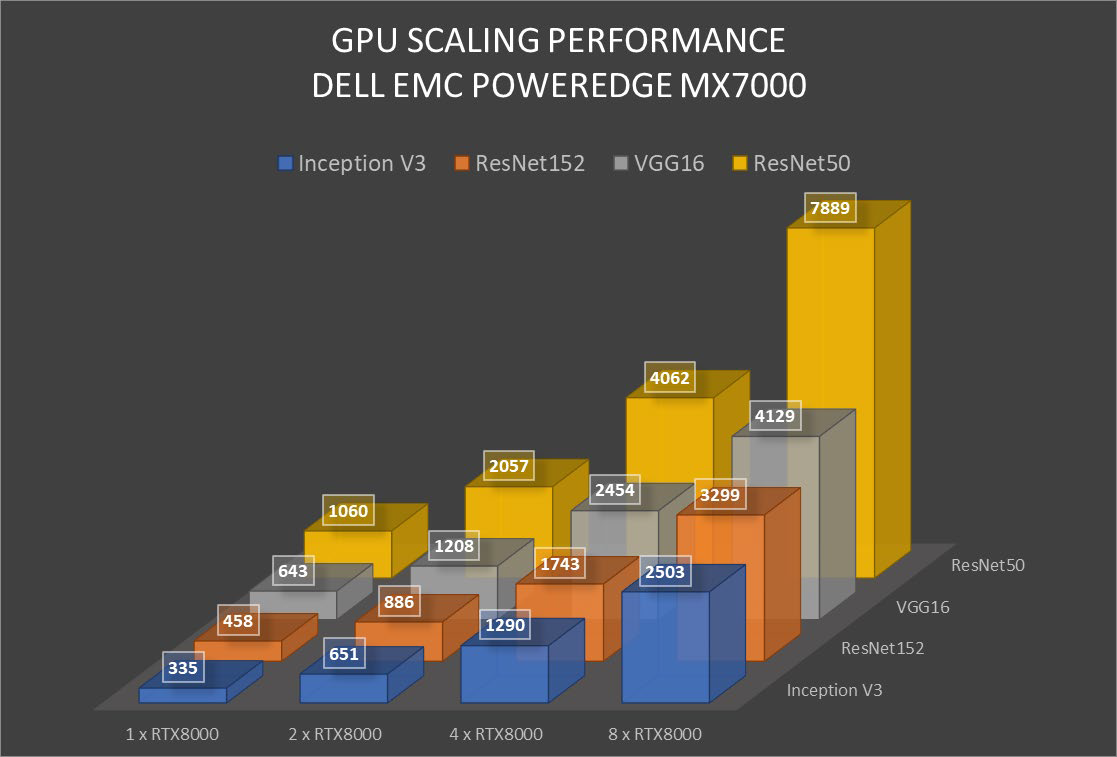
Figure 5 GPU Performance Scaling Comparison
- MX7000 Leverages RTX8000 in PCIe expansion chassis measured with P2P Enabled
Conclusion
Liqid PCIe expansion for the Dell EMC PowerEdge MX7000 unlocks the ability to manage the most demanding workloads in which accelerators are required for both new and existing deployments. Liqid collaborated with Dell Technologies Design Solutions to accelerate applications by through the addition of GPUs to the Dell EMC MX compute sleds over PCIe.
Learn More | See a Demo | Get a Quote
This reference architecture is available as part of the Dell Technologies Design Solutions.
Contact a Design Expert today https://www.delltechnologies.com/en-us/oem/index2.htm#open-contact-form

Dell EMC® PowerEdge™ MX750 Servers and MySQL Application Performance Gains with PCIe® 4.0 Technology
Mon, 16 Jan 2023 21:43:10 -0000
|Read Time: 0 minutes
Summary
This document summarizes a MySQL application performance comparison between the Dell EMC PowerEdge MX750 (with PCIe 4.0 technology) and the MX740 (with PCIe 3.0 technology). All performance and characteristics discussed are based on performance testing conducted in KIOXIA America, Inc. application labs. Results are accurate as of 5/1/21. Ad Ref #000072
Introduction
Dell EMC PowerEdge MX750 servers are based on the current PCIe 4.0 interface and the latest 3rd Gen Intel® Xeon® Ice Lake1 PCIe 4.0 scalable processors. Generationally, servers with PCIe 4.0 enable twice the bandwidth versus the previous PCIe 3.0 technology so peripheral devices, such as SSDs, GPUs and NICs can access data faster than ever before. The speed upgrade is well-suited for data-intensive and computational applications such as cloud computing, databases, data analytics, artificial intelligence, machine learning, container orchestration and media streaming. A faster PCIe interface enables today’s powerful CPUs, such as Ice Lake CPUs, to be continually fed with data.
To validate application performance and productivity gains that can be achieved with the PCIe 4.0 interface, KIOXIA Corporation, a leader in PCIe 4.0 SSD storage, compared the performance of a MySQL database application running on an MX750 server with PCIe 4.0 SSD technology versus an MX740 server with PCIe 3.0 SSD technology. The test process and results are presented.
System and Application Test Scenario
The tests utilized an operational, high-performance MySQL database workload that was based on comparable TPC-C™ benchmarks created by HammerDB software2. The MySQL database is commonly used in hyperscale and enterprise environments, and widely deployed on PowerEdge servers. It supports key applications such as webserver, online transactional processing (OLTP), e- commerce and data warehousing, and is the most widely deployed open source database globally (ranked number two overall3).
The tests on each server platform were conducted with PCIe 4.0 and PCIe 3.0 SSDs that measured transactions per minute (TPM), average read/write latency and CPU utilization. For the MX750 server, four (4) KIOXIA CM6 Series PCIe 4.0 enterprise NVMe® SSDs were deployed. For the MX740 server, four (4) PCIe 3.0 specification-compliant enterprise NVMe SSDs were deployed. The test results provide a real-world scenario of TPM performance, average read/write latency and CPU utilization when running a MySQL database application using comparable equipment and performing queries against it. Supporting details include a description of the test criteria, the set-up and associated test procedures, a visual representation of the test results, and a test analysis.
Test Criteria:
The hardware and software equipment used for these tests included:
Server Configurations:
Server Setup 1: One (1) Dell EMC PowerEdge MX750 dual socket server with two (2) Intel Xeon Ice Lake PCIe
4.0 CPUs, featuring 28 processing cores, 2.0 GHz frequency, and 512 gigabytes4 (GB) of DDR4 RAM
Server Setup 2: One (1) Dell EMC PowerEdge MX740 dual socket server with two (2) Intel Xeon Cascade Lake5 PCIe 3.0 CPUs, featuring 24 processing cores, 2.2 GHz frequency, and 384 GB of DDR4 RAM
- Operating System: CentOS™ v8.3
- Application: MySQL v8.0 (database size of 440 GB)
- Test Software: Comparable TPC-C benchmark tests generated through HammerDB v3.3 test software
- Storage Devices (Table 1):
SSD Setup 1: Four (4) KIOXIA CM6-V Series (3 DWPD6) PCIe 4.0 enterprise NVMe SSDs with 3.2 terabyte4 (TB) capacities
SSD Setup 2: Four (4) PCIe 3.0 specification-compliant (3 DWPD) enterprise NVMe SSDs with 3.2 TB capacities
Specifications | CM6-V Series | PCIe 3.0-compliant |
Interface | PCIe 4.0 NVMe (U.3) | PCIe 3.0 NVMe (U.2) |
Capacity | 3.2 TB | 3.2 TB |
Form Factor | 2.5-inch7 (15mm) | 2.5-inch (15mm) |
NAND Flash Type | BiCS4 3D NAND (96-layer) | V-NAND |
Drive Writes per Day (DWPD) | 3 (5 years) | 3 (5 years) |
Power | 18W | 20W |
DRAM Allocation | 96 GB | 96 GB |
Table 1: SSD specifications and set-up parameters
PLEASE NOTE: The MySQL database was limited to 96 GB of RAM. Although the total capacity available to the test system differs (512 GB for server setup 1 versus 384 GB for server setup 2), the actual amount of capacity used by each server setup was expected to be the same and not contribute to any performance advantage8.
Set-up & Test Procedures
Set-up: The MX750 and MX740 servers were setup with the CentOS™ v8.3 operating system and MySQL v8.0 software. The MySQL database was set to a maximum of 96 GB of DRAM and was placed into a RAID10 set. RAID10 was selected because it is commonly used in data center environments. Once each SSD array was initialized (PCIe 4.0 SSDs and PCIe 3.0 SSDs), the RAID10 set was formatted to the XFS file system. A 440 GB database was then loaded into each server setup (MX750/MX740) using HammerDB test software. Once the database was loaded, it was then backed up. Before each test run, the 440 GB test database was restored to the exact same state for each run to control the test inputs and database size.
Test Procedures: The first set of tests (TPM, latency and CPU utilization) were run on the MX750 server. The comparable TPC-C workload utilized HammerDB software to run the test. The four (4) KIOXIA CM6-V Series SSDs were then placed into a RAID10 set and the tests were conducted. Multiple iterations of each test were run to determine an optimal configuration of virtual users. A configuration of 480 virtual users delivered the highest TPM performance numbers. See Test Results section.
The first set of tests were run on the MX740 server. The comparable TPC-C workload utilized HammerDB software to run the test. The four (4) PCIe 3.0 specification-compliant SSDs were then placed into a RAID10 set and the tests were conducted. Multiple iterations of each test were run and a configuration of 480 virtual users delivered the highest TPM performance numbers. See Test Results section.
Test Results
The tests were conducted with the MX750 server (Ice Lake CPUs with PCIe 4.0 technology) versus an MX740 server (Cascade Lake with PCIe 3.0 technology), with the results recorded. For the TPM result, the higher the test value, the better the result. For the latency and CPU utilization results, the lower the test value, the better the result.
Transactions Per Minute
In an Online Transaction Processing (OLTP) database environment, TPM is a measure of how many transactions in the TPC-C transaction profile that are being executed per minute. HammerDB software, executing the TPC-C transaction profile, randomly performs new order transactions and randomly executes additional transaction types such as payment, order status, delivery and stock levels. This benchmark simulates an OLTP environment where there are a large number of users that conduct simple, yet short transactions that require sub-second response times and return relatively few records. The TPM test results:
TPM: MySQL Comparable TPC-C Workload | MX750 (PCIe 4.0) | MX740 (PCIe 3.0) |
TPM (higher is better) | 981,036 | 632,052 |
Advantage | +55% | - |
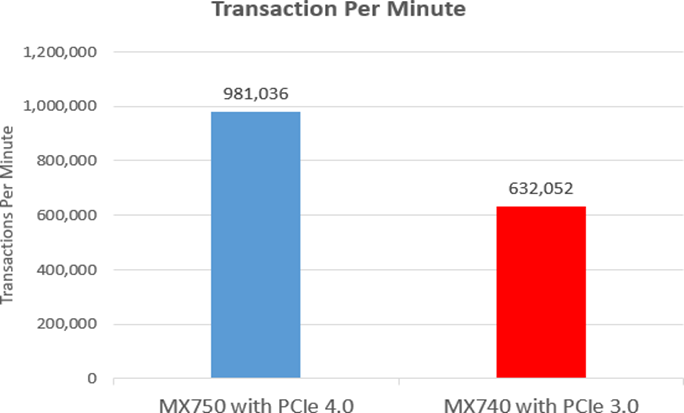
Average Read and Write Latency
Latency is the delay in time before a storage device completes a data transaction following an instruction from the host for that request, which can greatly affect application performance and the user experience. Application response time often has built-in latency between the user and the server, so maintaining low-latency within the server will usually translate into an overall better user experience. The read and write latency test results:
Latency: MySQL Comparable TPC-C Workload | MX750 (PCIe 4.0) | MX740 (PCIe 3.0) |
Average Read Latency (lower is better) | 0.09 ms | 0.11 ms |
Advantage | -18% | - |
Average Write Latency (lower is better) | 0.01 ms | 0.06 ms |
Advantage | -83% | - |

CPU Utilization
In general, CPU utilization represents a percentage of the total amount of computing tasks that are handled by the CPU, and is another estimation of system performance. For these tests, CPU utilization was measured to determine the unused CPU that is available for additional tasks, and where a lower result is better. The Dell MX750 server with the Ice Lake CPU has a 20% instructions per cycle (IPC) uplift over the previous CPU generation, which enables it to complete more instructions per clock cycle. The combination of higher transistor density (with the 10 nanometer fabrication process) and PCIe 4.0 technology results in faster storage transactions.
In this test scenario, the Ice Lake CPU was less taxed when running the test workload versus the MX740 server with the Cascade Lake CPU delivering about 46% utilization versus 89% utilization with the Cascade Lake CPU, as evident from the results:
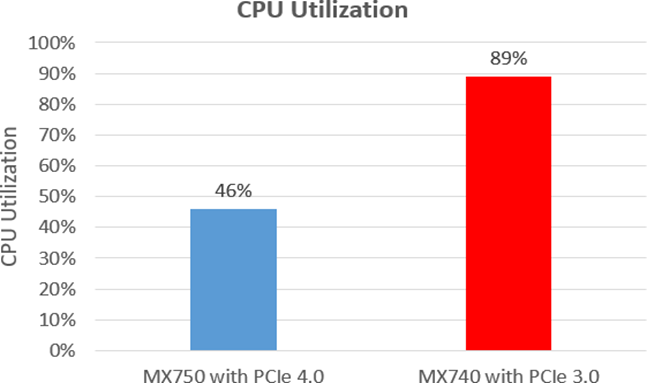
Test Analysis
The test results validated that a PowerEdge MX750 server with PCIe 4.0 technology, such as KIOXIA CM6-V Series SSDs, delivers about 55% better TPM performance versus the previous generation server with PCIe 3.0 technology. Almost a million transactions per minute were delivered within this PCIe 4.0 server/storage platform, which in turn, enables systems and applications based on the PCIe 4.0 interface to run at higher performance. In addition, PCIe 4.0 technology delivers faster access to data per the latency results, enabling data transactions to be completed faster.
Though the total capacity available to each test system differed (512 GB for server setup 1 versus 384 GB for server setup 2), the actual amount of capacity used by each server setup for the MySQL database was the same and did not contribute to any performance advantage.
It should also be noted that the MX740 server with the Cascade Lake CPU was slightly faster in frequency than the MX750 server with the Ice Lake CPU (2.20 GHz vs 2.0GHz), but had less processing cores (24 vs 28). As it related to the testing process, system performance was roughly comparable between the two test systems. Therefore, the combination of higher PCIe 4.0 performance in both the Intel Ice Lake CPU and the KIOXIA CM6-V Series SSDs enabled significantly more transactions per minute and better read/write latency.
At 46% CPU utilization, the MX750 server with the Ice Lake CPU and PCIe 4.0 technology was less taxed when running the test workload versus the MX740 server. At 89% CPU utilization, the MX740 server with Cascade CPU and PCIe 3.0 technology was nearing the maximum workload leaving very little room for the CPU to address additional tasks.
CM6 Series SSD Overview
The CM6 Series is KIOXIA’s 3rd generation enterprise-class NVMe SSD product line that features significantly improved performance from PCIe Gen3 to PCIe Gen4, 30.72TB maximum capacity, dual-port for high availability, 1 DWPD for read-intensive applications (CM6-R Series) and 3 DWPD for mixed use applications (CM6-V Series), up to a 25-watt power envelope and a host of security options – all of which are geared to support a wide variety of workload requirements.
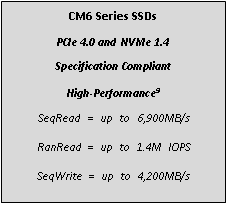
Summary
The test results presented validate that a Dell EMC PowerEdge MX750 PCIe 4.0 enabled server with KIOXIA CM6-V Series SSDs effectively delivered much faster TPM performance for MySQL database workloads than a comparable PCIe
3.0 system/server configuration.
Notes
1 Ice Lake is the codename for Intel Corporation’s 3rd generation Xeon scalable server processors.
2 HammerDB is benchmarking and load testing software that is used to test popular databases. It simulates the stored workloads of multiple virtual users against specific databases to identify transactional scenarios and derive meaningful information about the data environment, such as performance comparisons. TPC Benchmark C is a supported OLTP benchmark that includes a mix of five concurrent transactions of different types, and nine types of tables with a wide range of record and population sizes and where results are measured in transactions per minute.
3 Source: https://db-engines.com/en/ranking, January 2021.
4 Definition of capacity - KIOXIA Corporation defines a megabyte (MB) as 1,000,000 bytes, a gigabyte (GB) as 1,000,000,000 bytes and a terabyte (TB) as 1,000,000,000,000 bytes. A computer operating system, however, reports storage capacity using powers of 2 for the definition of 1Gbit = 230 bits = 1,073,741,824 bits, 1GB = 230 bytes = 1,073,741,824 bytes and 1TB = 240 bytes = 1,099,511,627,776 bytes and therefore shows less storage capacity. Available storage capacity (including examples of various media files) will vary based on file size, formatting, settings, software and operating system, and/or pre-installed software applications, or media content. Actual formatted capacity may vary.
5 Cascade Lake is the codename for Intel Corporation’s 2nd generation Xeon scalable server processors.
6 Drive Write(s) per Day (DWPD): One full drive write per day means the drive can be written and re-written to full capacity once a day, every day, for the specified lifetime. Actual results may vary due to system configuration, usage, and other factors.
7 2.5-inch indicates the form factor of the SSD and not the drive’s physical size.
8 Modifying DRAM usage can impact performance. The purpose of this testing was to stress SSD performance. 96GB of DRAM was allocated to prevent the database from being cached into DRAM as that would reduce stress on the storage devices.
Trademarks
CentOS is a trademark of Red Hat, Inc. in the United States and other countries. Dell, Dell EMC and PowerEdge are either registered trademarks or trademarks of Dell Inc. Intel and Xeon are registered trademarks of Intel Corporation or its subsidiaries in the U.S. and/or other countries. MySQL is a registered trademark of Oracle and/or its affiliates. NVMe is a registered trademark of NVM Express, Inc. PCIe is a registered trademark of PCI-SIG. TPC-C is a trademark of the Transaction Processing Performance Council. All company names, product names and service names may be the trademarks of their respective companies.
Disclaimers
© 2021 Dell, Inc. All rights reserved. Information in this application brief, including product specifications, tested content, and assessments are current and believed to be accurate as of the date that the document was published, but is subject to change without prior notice. Technical and application information contained here is subject to the most recent applicable product specifications.

PowerEdge MX Validate Baseline to Improve Operational Efficiency
Mon, 16 Jan 2023 21:29:16 -0000
|Read Time: 0 minutes
Summary
Modern compute platforms consist of many components requiring multiple firmware elements. This can lead to complexity and risk when updating these components. To eliminate this problem for MX customers, Dell produces a biennial firmware baseline and validates the complete end-to-end stack with testing built on real customer use cases. Dell OpenManage system management orchestration then offers a simple route to update, at scale, live environments to this desired state.
This Direct from Development (DfD) tech note describes at a high level the Dell methodology for applying updates with no disruption in service. This enables lowering risk, streamlining the update process, and saving time for organizations.
Market positioning
The PowerEdge MX is a scalable modular platform comprising compute, networking, and storage elements, and designed for data center consolidation with easy deployment and rich integrated management. PowerEdge MX features an industry- leading no midplane design and scalable network fabric, within a chassis architecture to support today’s emerging processor technologies, new storage technologies, and new connectivity innovations well into the future.
PowerEdge MX firmware baseline
Reduce complexity and simplify operations by leveraging Dell’s MX validated solution infrastructure firmware baseline. This is a set of system and component firmware for
the MX platform that is rigorously tested as “one release” in a number of configurations, using the most popular operating system environments based on real world customer use cases. When the updates have passed this testing as a group, a validated solution stack firmware catalog that details the release versions is published. Several solutions in the OpenManage portfolio can then consume the catalog as an update blueprint.
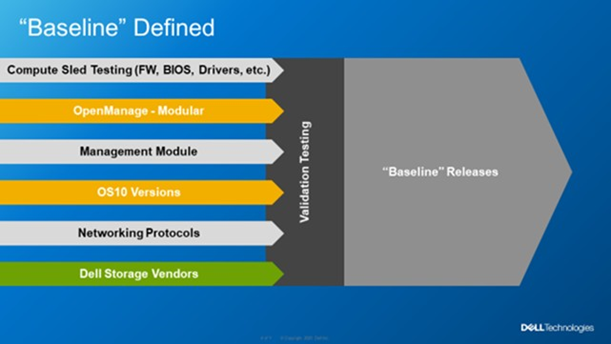 Figure 1. MX Baseline Components
Figure 1. MX Baseline Components
Dell MX firmware baselines offer customers an elegant and automated method for platform wide updates. Advantages for customers include:
- Aggregates multiple releases into one consolidated update
- Dell end-to-end validation helps eliminate the risk of element incompatibility
- Reduces the number of maintenance windows and the amount downtime required for updating
Anatomy of the PowerEdge MX baseline
The PowerEdge MX validated solution baseline consists of many elements, including system BIOS, iDRAC, NICs, CNAs, fibre channel adapters, HBAs and other critical updates. In addition, the stack extends into the chassis to include network switch code and management controller software “OME-M”. The MX platform baseline testing includes the Chassis I/O Modules such as MX9116n, MX7116n, MX5108, and MXG610 capabilities in all forms with scaled VLANs. It also includes testing with different configurations, protocols, and workloads. For Fiber Channel and FCoE, baseline testing also includes testing scenarios in NPIV Proxy Gateway, FIP Snooping Bridge, and Direct Attached mode. An example end-to-end stack test is VMWare ESXi running on the compute sleds connected to a PowerStore storage array using FCoE Ethernet and testing updating from an old baseline to the new baseline. When the Dell updates pass evaluation, a validated solution stack of the platform firmware catalog file containing details of the tested versions is published online ready to be consumed by Dell update mechanisms, such as the update manager integrated into OME. Think of the validated baseline as a recipe for success.
When it comes to apply updates, Dell’s OpenManage system management automation provides a timesaving centralized process with intelligent safeguards to eliminate downtime. The benefits of using OME-M to perform updates using the catalog include: automatically identifying components that require updates, downloading the updates from the Dell support site, creating and scheduling update jobs, correctly ordering tasks, and reporting. The following example shows a sample catalog, highlighting the non-compliant elements. An administrator needs only to click the “Make Compliance” to start the task to update multiple elements in the MX environment.

Figure 2. Detailed view of a firmware update
VMware enhancement
For customers running their VMware environment on PowerEdge MX platform, this firmware update process can be enhanced using OMEVV (OpenManage Enterprise plugin for VMware vCenter) to be “VMware cluster” aware, in order to safeguard services from outages. Cluster aware updates mean intelligent rules that allow patching only one member of a VMware cluster at a time. Leveraging ESXi maintenance mode, DRS, and vMotion, before patching a physical host,
virtual machines are systematically migrated “hot” to other ESXi hosts, ensuring that workloads and services running on the cluster are kept online at all times. After applying the updates, the host restarts and re-joins the cluster. DRS can then live migrate virtual machines back to the newly updated host. This sequence is repeated for each host in the cluster, offering a controlled rolling upgrade for the entire cluster.

Figure 3. OMEVV/VMware host rolling updates
OMEVV also includes a scheduling engine to manage timed updates during quiet periods or to set maintenance windows. Larger customers can run parallel updates on up to 15 clusters simultaneously from a single console.
IOMs
If a customer is using an MX environment with MX9116n/MX7116n network switches in SmartFabric mode, they simply select “make compliant” from the OME-M GUI. No searching for the correct switch code, no manual upload code to the switch, it is all taken care of as part of the catalog. OME-M interfaces with switches to upload the new code. If the switches are configured as a pair, the update runs automatically on one switch at a time to ensure problem free connectivity during the updates.
RESTful API
The OpenManage Enterprise APIs enable the customer to integrate with other management products such as Ansible play books or build tools based on common programming and scripting languages, including Python and PowerShell. These APIs are fully documented. Dell posts many examples on GitHub code repository for administrators / developers to download and use for free.
In Conclusion
Customers who rely on Dell PowerEdge MX for their compute needs can streamline the update process, saving time and ensuring firmware compliance, by leveraging MX validated solution stack firmware baselines. In addition, for VMware environments, intelligent rolling firmware updates for hosts offer updating with zero service outages, and no end user downtime.
References
To learn more, see:


